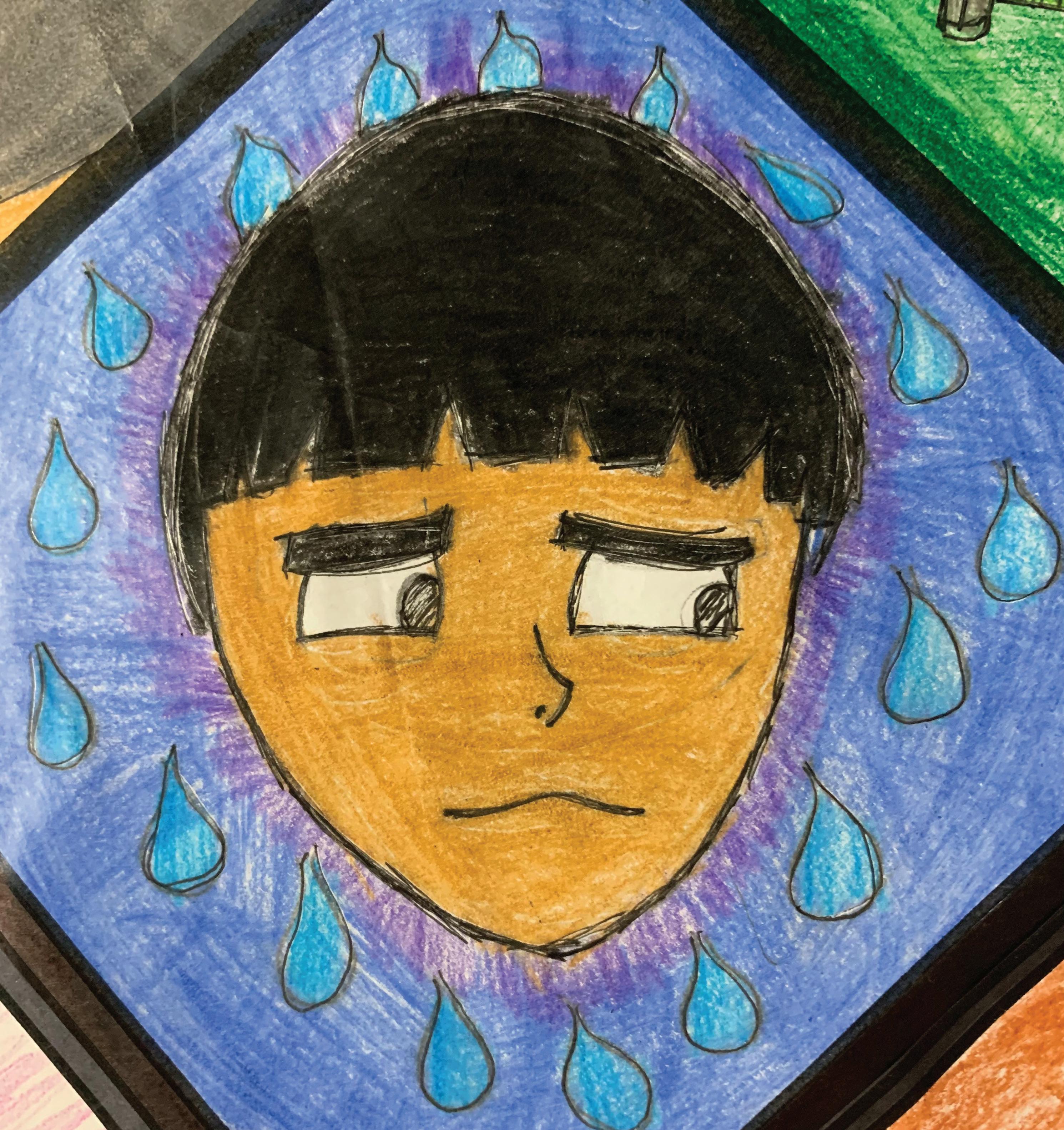IN THIS ISSUE
Streetfront: Students go the distance, reach new heights

pages 20–23
Witness blanket: A project toward reconciliation
pages 8–11
BCTF AGM 2023
pages 26–35

Streetfront: Students go the distance, reach new heights

pages 20–23
Witness blanket: A project toward reconciliation
pages 8–11
BCTF AGM 2023
pages 26–35



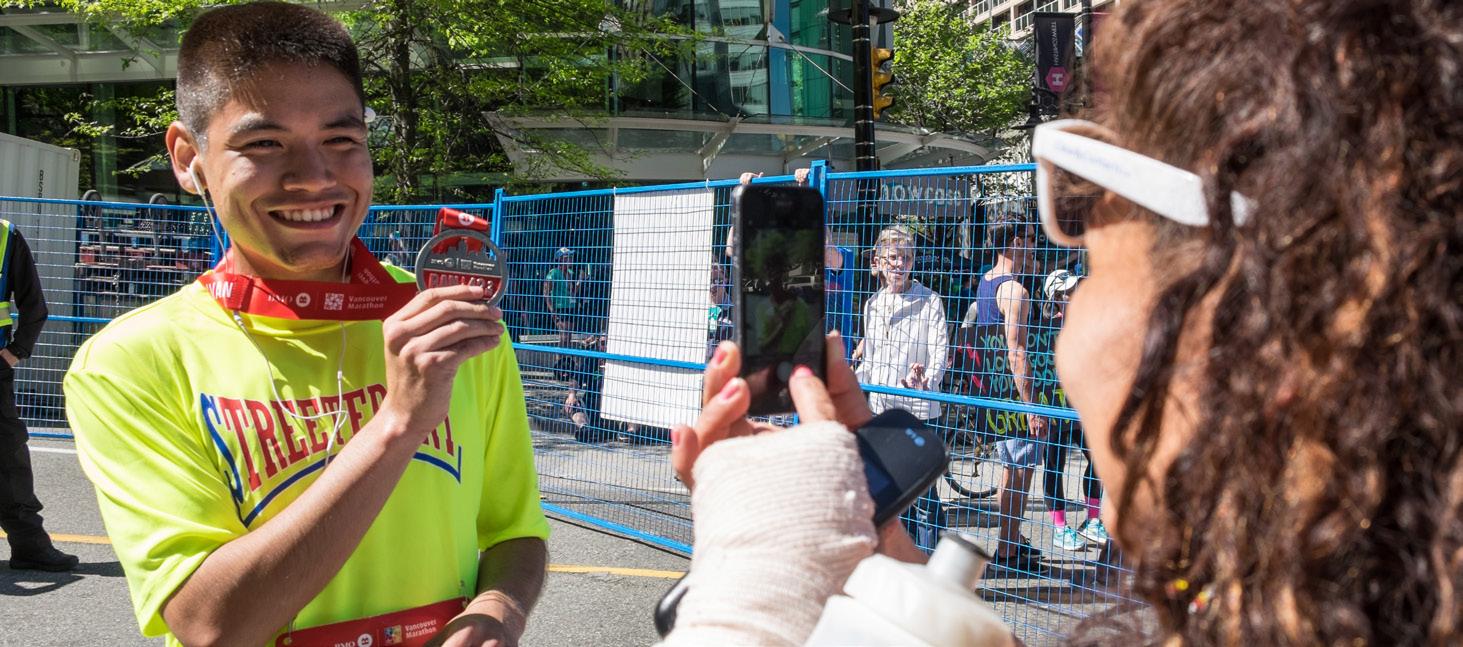
18
Articles reflect the views of the authors and do not necessarily express official policy of the BCTF. The BCTF does not endorse or promote any products or services advertised in the magazine. Advertisements reviewed and approved by the BCTF must reflect BCTF policy and be politically, environmentally, and professionally appropriate.

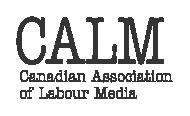
Live links are available in the digital version of Teacher magazine: bctf.ca

Do you enjoy writing? Have a story to tell? Know of a project at your school or in your local you want to share with colleagues? Then consider writing for Teacher, the flagship publication of the BCTF! Submission guidelines are available at bctf.ca.
We also welcome letters to the editor. Send your letter to teachermag@bctf.ca
Teacher reserves the right to edit or condense any contribution considered for publication. We are unable to publish all submissions we receive.
BCTF Executive Committee
Contact us

BC Teachers’ Federation
Toll free 1-800-663-9163
Email teachermag@bctf.ca Web bctf.ca

Editor Sunjum Jhaj, sjhaj@bctf.ca
Assistant Editor/Designer
Sarah Young, syoung@bctf.ca
Advertising
Delaney Steel, dsteel@bctf ca
ISSN 0841-9574

Jelana Bighorn Clint Johnston
Bénula Bunjun Lisa LaBoucane
Kevin Epp Teri Mooring
Mariah Franzmann Jody Polukoshko
Carole Gordon Robin Tosczak
Rick Joe Katherine Trepanier Winona Waldron
Teacher Magazine Advisory Board
Shelley Balfour Jennifer Fox
Mahima Lamba Kristin Singbeil
Robyn Ladner

As spring approaches, we move into a critical time for advocacy within education. Throughout March, school districts will receive their projected allotment for funding and begin their process to pass a budget. The BCTF will continue to work to raise awareness of the challenges we are facing in a severely underfunded system.
We are continuing our work with the newly appointed Minister of Education and Child Care on several of the issues affecting BCTF members, including recruitment and retention issues across the whole province. A lack of teachers means a lack of supports available to students, and members missing out on prep time and remedy because there are not enough teachers in the system. As part of our advocacy, the BCTF is calling on districts and the Ministry to collect and disclose accurate information on the number of uncertified teachers working in BC public schools.
Over the past several months we have also reached some important milestones in our equity and inclusion work within the BCTF.
First, our new Anti-Racism and Anti-Oppression Office (ARAOO) has launched a series of dialogue sessions for members that are part of the bigger systemic review of racism within the BCTF. The dialogue sessions will help us better understand gaps, barriers, and opportunities to dismantle systemic racism.
Recently, the BCTF has also published a report on the Policing in Schools Project. In early 2022, BCTF members who identify as Black, Indigenous, and people of colour came together to contribute their experiences and perspectives to this project. I’d like to express my appreciation and thanks to the members who shared knowledge gained from lived experiences with police in schools, including some deeply personal stories. Your work will help make BC schools safer for all students and staff.
The following three key themes emerged from the project and are highlighted in the final report:
• History matters and continues to be lived. Police presence in schools continues to be a source of discomfort, disruption, fear, and harm for many participants in the project.
• Student needs within a chronically underfunded public education system cannot be met by funding school liaison officers (SLOs). Police in schools have helped fill gaps in our underresourced education system; however, fully funded programs and staff positions can better support the needs of all students.
• Schools that embody care and meet student needs are grounded in the community and connected to families. A holistic approach to students’ academic, emotional, social, and physical well-being is grounded in community and is designed to meet the needs of the most vulnerable in the community.
As such, the BCTF has issued a statement calling for police in school programs to be replaced with fully funded programs staffed by other professionals in schools including counsellors, social workers, Aboriginal support workers, and others who provide localized community services.
I encourage all members to read the full report online, by scanning the QR code below, and reflect on how we can collectively take action to make schools safer and more inclusive for everyone.

Finally, I’d like to thank each of you for thoughtfully and meaningfully engaging in dialogue, learning, and advocacy that enables us to create safe, inclusive, and supportive school communities. Thank you for all you do for public education in British Columbia.

In solidarity,
Clint Johnston BCTF PresidentÀ l’approche du printemps, nous entamons une période critique pour la défense des intérêts au sein de l’éducation. Tout au long du mois de mars, les conseils scolaires recevront leurs prévisions de financement et amorceront leur processus pour l’adoption d’un budget. La FECB continuera à travailler à la sensibilisation concernant les défis auxquels nous sommes confronté.e.s dans un système largement sous-financé.
Nous poursuivons notre travail avec la nouvelle ministre de l’Éducation sur de nombreux problèmes qui touchent les membres de la FECB, notamment les problèmes de recrutement et de rétention dans toute la province. Un manque de personnel enseignant est synonyme d’un manque de soutien pour les élèves et les membres manquent de temps de préparation et de réparation parce qu’il n’y a pas assez d’enseignant.e.s dans le système. Dans le cadre de notre plaidoyer, la FECB demande aux conseils scolaires et au ministère de recueillir et de divulguer des informations précises sur le nombre d’enseignant.e.s non certifié.e.s travaillant dans les écoles publiques de la Colombie-Britannique.
Au cours des derniers mois, nous avons également franchi des étapes importantes dans notre travail d’équité et d’inclusion au sein de la FECB.

Tout d’abord, notre nouveau Bureau de lutte contre le racisme et l’oppression (ARAOO) a lancé une série de sessions de dialogue pour les membres qui font partie de l’examen systémique plus approfondi du racisme au sein de la FECB. Ces séances de dialogue nous aideront à mieux comprendre les lacunes, les obstacles et les possibilités pour démanteler le racisme systémique.
Récemment, la FECB a également publié un rapport sur le projet Policing in Schools (maintien de l’ordre dans les écoles). Au début de 2022, les membres de la FECB qui s’identifient comme Noir.e.s, Autochtones et personnes de couleur se sont réuni.e.s pour apporter leurs expériences et leurs perspectives à ce projet. J’aimerais exprimer mon appréciation et mes remerciements aux membres qui ont partagé leurs connaissances issues d’expériences vécues avec la police dans les écoles, y compris certaines histoires profondément personnelles. Votre travail contribuera à rendre les écoles de la Colombie-Britannique plus sûres pour tous.tes les élèves et le personnel.
Les trois thèmes clés suivants ont émergé du projet et sont soulignés dans le rapport final :
• L’histoire est importante et continue d’être vécue. La présence de la police dans les écoles continue d’être une source de malaise, de perturbation, de peur et de préjudice pour plusieurs participant.e.s au projet.
• Les besoins des élèves au sein d’un système d’éducation publique sous-financé de façon chronique ne peuvent être satisfaits en finançant des agent.e.s de liaison scolaire (SLOs). La présence de la police dans les écoles a contribué à combler les lacunes de notre système éducatif sous-financé. Cependant, des programmes et des postes de personnel entièrement financés peuvent mieux répondre aux besoins de tous.tes les élèves.
• Les écoles qui incarnent la bienveillance et répondent aux besoins des élèves sont ancrées dans la communauté et connectées aux familles. Une approche holistique du bien-être scolaire, émotionnel, social et physique des élèves est enracinée dans la communauté et est conçue pour répondre aux besoins des plus vulnérables de la communauté.
C’est pourquoi la FECB a publié une déclaration demandant que les programmes de police dans les écoles soient remplacés par des programmes entièrement financés dans les écoles et confiés à d’autres professionnel.le.s, notamment par des conseiller.ière.s, des travailleur.euse.s sociaux.ales, des intervenant.e.s autochtones et d’autres personnes qui assurent des services communautaires localisés.
Je vous encourage tous.tes à lire le rapport intégral en ligne, en scannant le code QR de la page 4, et à réfléchir à la façon dont nous pouvons collectivement agir pour faire en sorte que les écoles soient plus sûres et plus inclusives pour tous.tes.
Enfin, j’aimerais remercier chacun.e d’entre vous pour votre engagement réfléchi et significatif dans le dialogue, l’apprentissage et la défense des intérêts qui nous permet de créer des communautés scolaires sûres, inclusives et solidaires. Merci pour tout ce que vous faites pour l’éducation publique en Colombie-Britannique.
En toute solidarité,
Clint Johnston Président de la FECBThis gathering is about acknowledging and celebrating who we are: as Indigenous people, from a variety of backgrounds, and as professionals—as teachers. In our Coast Salish way, we stand you up, we acknowledge who you are, what you do. We stand you up because we have faced challenges being Indigenous in a system that does not always support our identities. No matter where you are in your journey, in your understanding of your Indigenous identity, we stand you up. As you stand, you honour your heritage, your ancestors. When you stand, you bring hope to our peoples—we have people who look like us, who understand our histories, our concerns, our dreams. We stand you up.
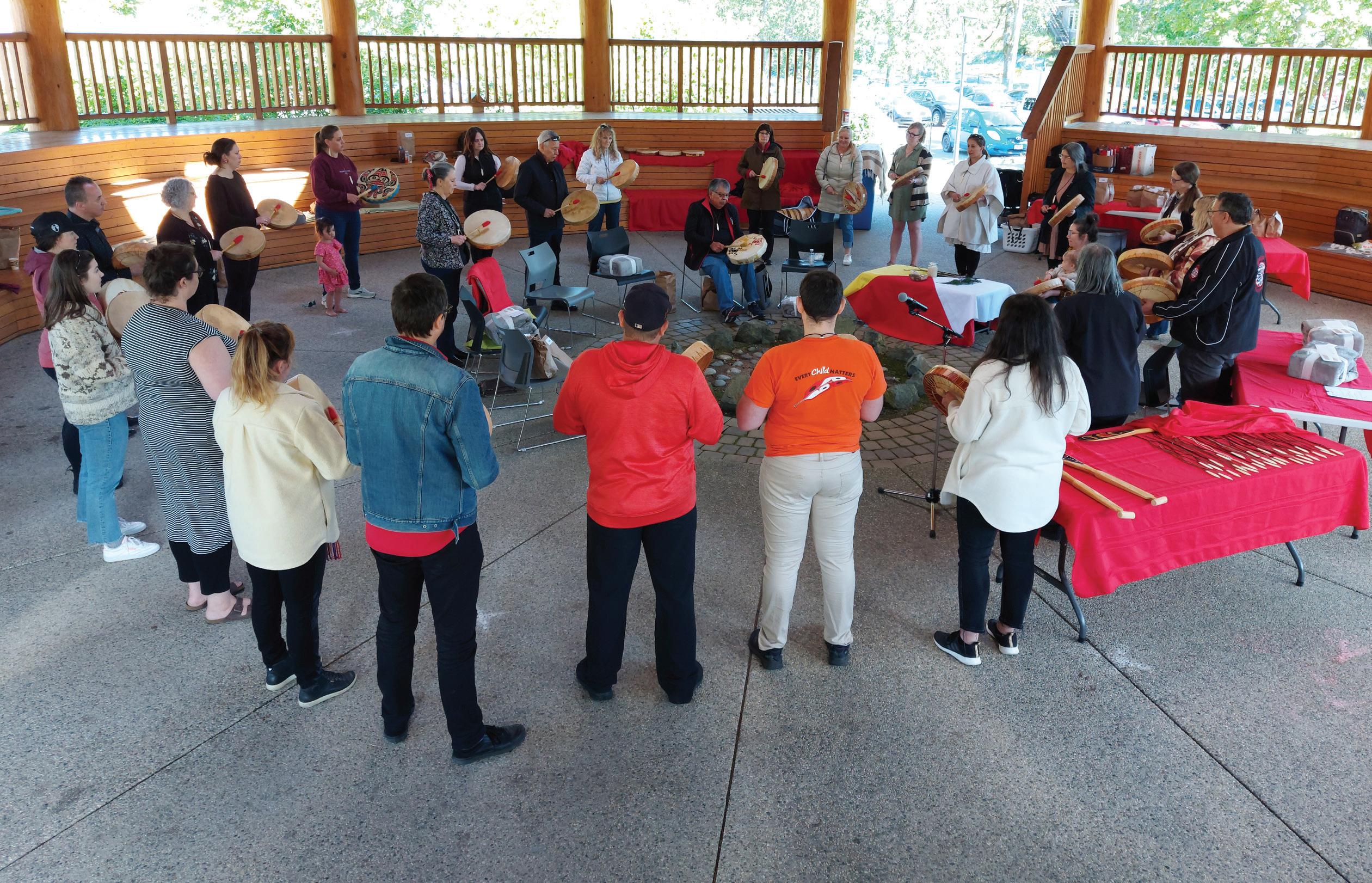
– Frank Conibear, GVTA IEC Chair, during creation of Nutsa’maat
This article was written collaboratively with the members of the Greater Victoria Teachers’ Association (GVTA) Indigenous Education Committee (IEC) to whom I owe many thanks.
I’LL NEVER FORGET the day that I opened my carefully crafted gift bag from our Nutsa’maat Mentorship Circle. As I looked through the contents and put them on the table in front of me in preparation for the online gathering, I felt a wave of thoughts and emotions overcome me.
As an Indigenous man who was adopted out and grew up away from my ancestral community, I’ve struggled to find a sense of belonging. I’ve often felt a strong desire to tap into my heritage, but this has felt inaccessible to me. Many nonIndigenous people remark to me that they had no idea I’m Indigenous when I tell them, and I’ve also had a hard time feeling like I fit in with the Indigenous communities around me. After all, while living in the relative privilege of my adoptive home, I never endured the same kind of hardships as my aunties and uncles, so who am I to stake claim of my indigeneity? This is what it feels like to be urban Indigenous, and Nutsa’maat taught me that I’m not alone.

As I unpacked the four traditional medicines (tobacco, sweetgrass, cedar, and sage) and the beautiful abalone shell, I felt a sense of belonging as an Indigenous teacher together with other Indigenous teachers in a way that I’d never felt before. Each teacher who was personally invited to the gathering was gifted the same four medicines. Over several sessions we all sat together in a (virtual) circle, shared our thoughts about common issues, laughed and sometimes cried together—most importantly, we all knew that we were safe no matter where we were on our personal journeys.
Nutsa’maat became a reality after the BCTF finished its previous round of bargaining in March 2020. The BCTF and the Ministry of Education bargained a one-time lump sum of $12,000,000 to support mentorship and early career teachers across the province, informally called the CA19 grant, which was distributed among the 60 school districts in BC.
The GVTA Indigenous Education Committee requested part of the CA19 grant to bring Indigenous teachers together in a mentorship program. We felt there was a great need for Indigenous teachers to connect no matter what their background. Many Indigenous teachers experience being the only Indigenous staff member in their school, and many more have only a few Indigenous colleagues who they can meet with to connect, discuss common issues, and seek help from. While this describes many new Indigenous teachers, there are also many more experienced teachers still learning about their roots or only now finding out about and embracing their Indigenous heritage. We didn’t want Indigenous teachers to feel isolated and decided to build a mentorship community for all Indigenous teachers.

Frank Conibear, the chair of the Indigenous Education Committee at the time of the CA19 grant, had the idea for an Indigenous mentorship circle in his heart for many years, so when the funding came, we knew that we were going to create a mentorship program centred around community. Nutsa’maat is the Hul’qumi’num word for “one heart, one mind” and is an embodiment of the approach toward mentorship that we are trying to achieve.
We want to stand up our Indigenous teachers and recognize them as Indigenous people. Our Nutsa’maat gatherings allowed for non-Indigenous people to stand us up and stand with us in circle. The goal of these gatherings is to honour and celebrate, while also acknowledging the challenges of being an Indigenous educator. Indigenous mentorship is working together, collaborating, and sharing each other’s gifts. We want to build a strong, connected circle of support for each other.
In person or on Zoom, Nutsa’maat is intended to be like a circle. We had four Elders witnessing our work at each of our meetings. Our online meetings included rounds of discussions with questions and interactive activities. Last year, we were also able to gather in person for the first time. This was a special occasion with participants sitting together and drumming in a circle. We’ve had two meaningful years and have received many messages about the positive impact this program has had on the lives of participants.
In many ways Nutsa’maat has nourished the part of me that craves a sense of community. Meeting with my fellow Indigenous teachers from many backgrounds has also inspired me to own my personal history and the unique events that have shaped me to be who I am. One thing that I’ve learned from teaching is that the more at home students feel in the classroom, the more they can feel like their true selves and learn harmoniously with others. This is also true for teachers. If we lead by example and let our authentic selves shine through to our students, our students will respond in kind. •
TOP LEFT: Drumming in circle, May 2022. CENTRE LEFT: The Four Sacred Medicines: sweetgrass, tobacco, sage, and cedar. BOTTOM RIGHT: Standing together as Indigenous educators, May 2022. Author’s photos .Nutsa’maat is the Hul’qumi’num word for “one heart, one mind” and is an embodiment of the approach toward mentorship that we are trying to achieve.
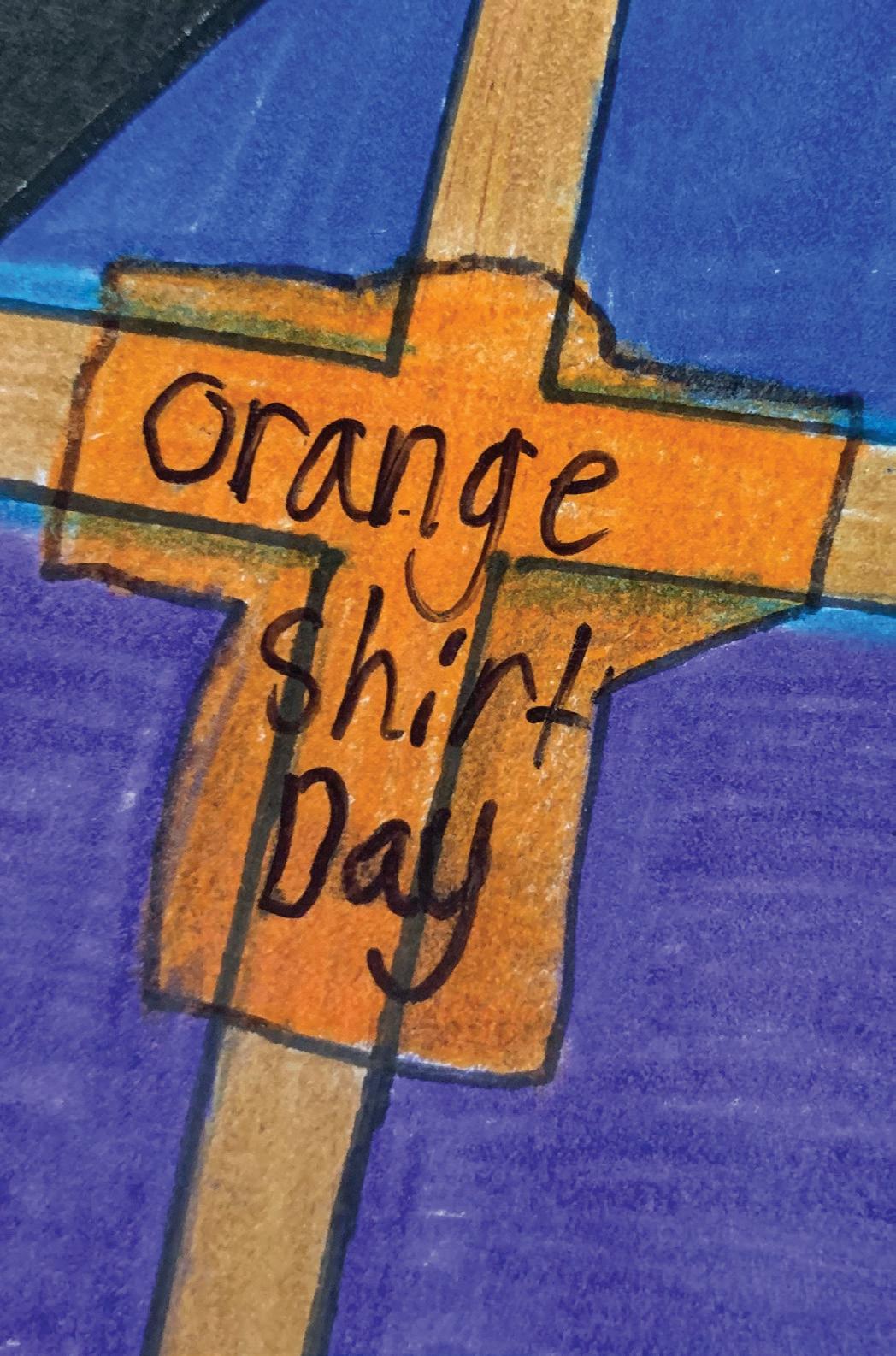


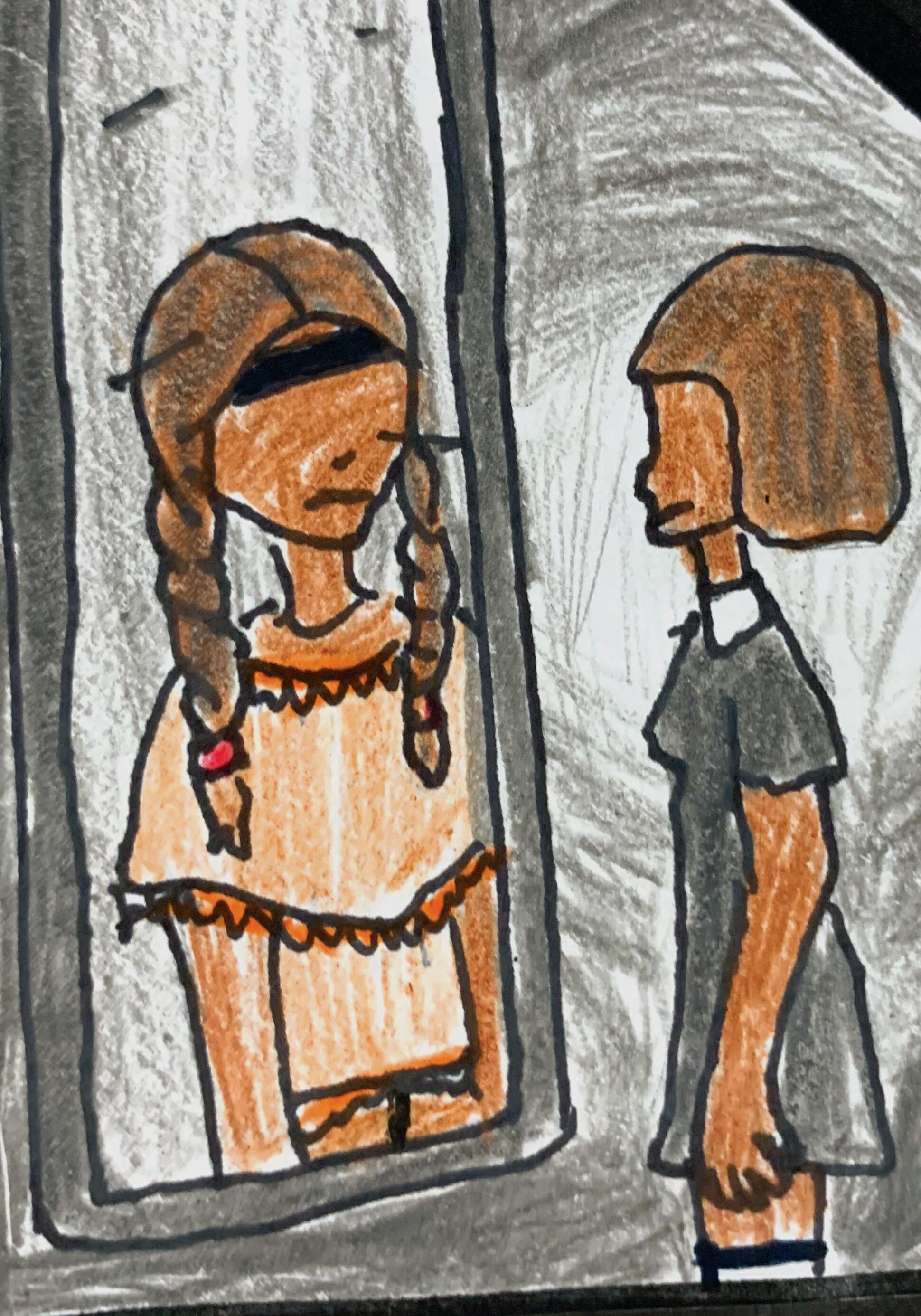
AS EDUCATORS (and citizens), we are now aware that Canada has a deplorable history with regard to its dealings and relationship with Indigenous, Métis, and Inuit people. As a child of the late 1970s, educated in the 1980s and 1990s, I do not recall learning anything significant about our national history, save some lessons around Louis Riel and potentially some artwork here and there. The children we are educating now have a very different experience in the classroom.

I graduated from the University of the Fraser Valley Bachelor of Education program in 2020. As a recent graduate, I had the benefit of taking a class in Indigenous education and had professors who supported and required us to consider social justice in everything we undertook. This school year is my third, and I am privileged to be a founding member of the new Stitó:s (place of crossing) Lá:lém Totí:lt (house of learning) Elementary Middle School, which is located along the Vedder River in the unceded, ancestral, and traditional territory of the Pilalt, Ts’elxwéyeqw, and Semá:th people in Chilliwack.
Educators face a challenge in how to indigenize curriculum while also being careful not to inadvertently misstep. I don’t know many teachers who enter the classroom without some fear and trepidation about being disrespectful, using inappropriate resources, providing a token lesson without appropriate depth or purpose, or any number of other mistakes that may arise when we consider how to provide historical information and share Indigenous ways of knowing. This is a major barrier to many of us and can prevent some from taking necessary risks and pushing outside our comfort zones. Regardless of how unprepared we may feel, I think it is vital that we keep our hearts and minds open and approach the indigenization of our curriculum with purpose and intention, ensuring that we do the personal work toward reconciliation so that we can authentically guide our students to do the same.
Last September, around Orange Shirt Day, Taleen Candy, my partner teacher, and I wanted to expand the breadth of
our teaching, as well as offer our mixed class of Grade 6 and 7 students a variety of methods to express their learning. We wanted to use arts-based education to bring important learning around residential schools into our classrooms.
We started with exploring Orange Shirt Day and residential school stories and facts. We then had students explore both the book and the video for the Secret Path by Gord Downie and Jeff Lamire. We asked students to consider the way colour is used in the artwork to express emotion. Students created their own medicine wheel connected to their learning of the Secret Path and the journey of Chanie Wenjack. This medicine wheel required students to express their learning through hand-drawn images, using the colours and directions of the wheel to explore different aspects of the lesson objectives. Based on a learning experience I had during my B.Ed., we presented students with songs by Indigenous artists, such as The Jerry Cans and Supaman, and asked them to consider how music and music videos affected the message of the song. Students completed a written or artistic response to each song.
Thanks to our amazing district Indigenous Education Department and with the in-class support of our school Indigenous Education Team, students were lucky to be able to participate in the Blanket Exercise, exploring the long history of colonization on the lands and people of Turtle Island.
As a class, we learned about various aspects of the Indian Act and watched the documentary Picking Up the Pieces: The Making of the Witness Blanket about the creation of the Witness Blanket by artist Carey Newman. (This film contains some coarse language, so it should be prescreened if you plan to share it with students.) Through all of these activities we facilitated ongoing discussion, sharing of thoughts and feelings, and encouraged students to start to understand how the past has affected the current Canadian social dynamics and to understand the goal of reconciliation.
While prescreening the documentary, I had the idea to have our students, 54 in total, create their own witness blanket squares. I designed each blanket panel to represent the work of nine students, and each student was required to artistically present five truths that they would bring forward in their
OPPOSITE AND PAGES 10–11: Photos of student art and assembled witness blanket provided by author. teacher living and working on theunceded, ancestral, and traditionalterritories of the Pilalt, Ts'elxwéyeqw, and Semá:th people in Chilliwack
lives and witness about the Indigenous history of Canada. While talking about the Indian Act, we started to delve into the Truth and Reconciliation Commission’s report and talked with students about why we learn about these historical and current issues facing our society. We tried to impart the importance of using knowledge to identify bias and encourage empathy.

I liked the idea of using art to represent learning, as many students embrace drawing in the classroom—and when they know that their artistic ability is not going to be “graded,” there is a higher rate of buy-in by students. While many students can struggle with expressing their learning or thoughts in writing, drawing and art can give them an opportunity to really poke around in the new learning and help them internalize the lessons in a different way. I have also found that using drawing to express learning requires students to think both critically and creatively.
To help students with the transition from knowledge to images, Taleen and I did our own blanket squares, each of us drawing five truths that we carry forward in our own lives. We were purposeful in ensuring students understood that this was personal to each of them, that the image only really had to make sense to them, and that the truth did not have to be something that came directly from the learning we did as a class. Students required some help in how to represent their truth (or a piece of learning) in an artistic manner, and we were thrilled to observe students talking to each other and brainstorming ways to make their pictorial representations.
Once the drawings were complete, students were required to write an explanation for each of their drawings and to then write a summarizing paragraph stating what this process means to them in their own journey toward reconciliation. On the opposite page is a sample of student statements about the process and project.
The end result was an approximately 16′ x 3.5′ witness blanket that was displayed in our Grand Hallway (pictured below).

The blanket squares and pattern that I created can be reproduced by any teacher who wants to make a blanket in their own class/school. The pattern can be made smaller or larger. It is great way to use art to support learning and create a memorable and effective piece at any grade level. •
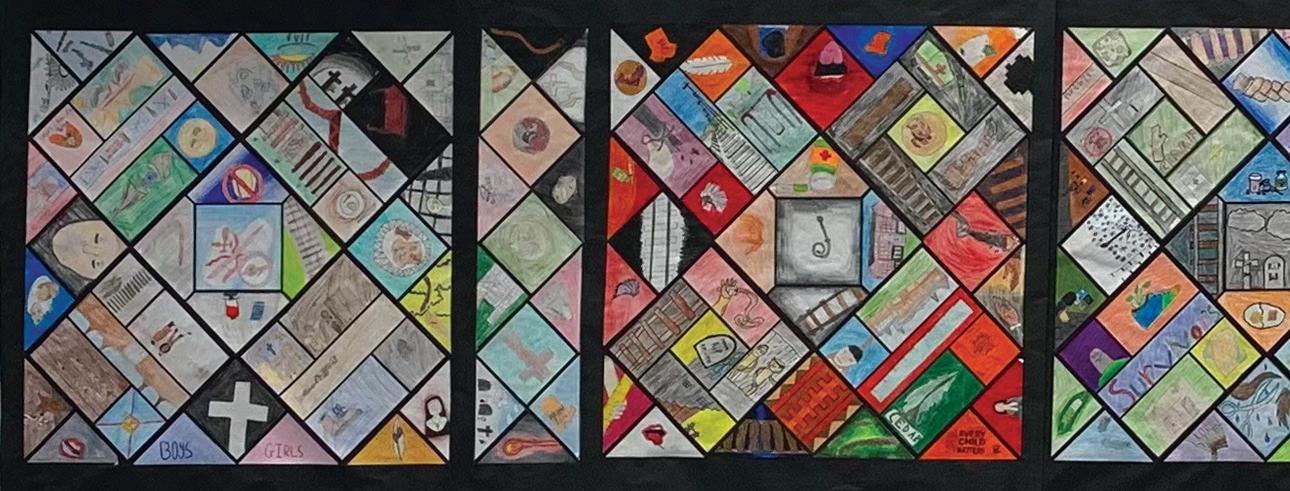
This witness blanket project is important for reconciliation in Canada because it teaches me about the experiences First Peoples had…and this knowledge I can pass on to others. This way, if people pass this on and on, more will come to light and we can understand to be respectful and make up for actions Canada did in the past. – R.S., Grade 7
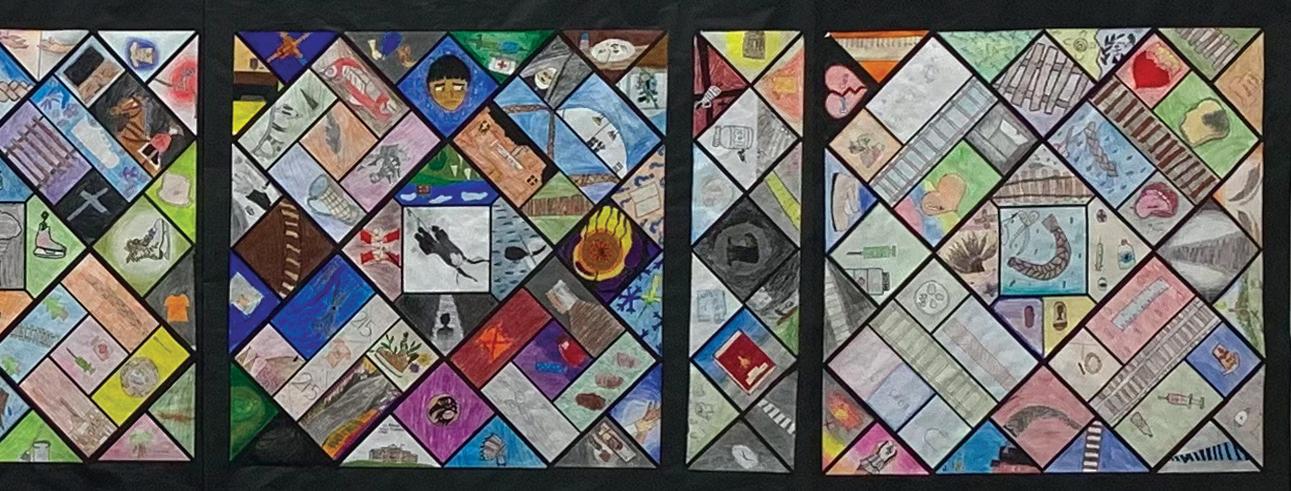
We bring five truths forward to recognize the things that happened in the past and to spread more awareness so things like that cannot happen again. – A.T., Grade 7
This taught me a lot about how Canada treated Indigenous people and how awful it was. This is part of reconciliation because it helps other people know more about how Canada treated Indigenous people. – K.P., Grade 7
I learned that, no matter how long ago it was, the scary effect still lasts on, and it can make it hard to live a normal life after residential schools. – A.D., Grade 7
This is part of reconciliation because it’s important that we know the truth of what happened and how we can make things better now by listening and understanding. – L.P., Grade 6

IF YOU’RE A CLASSROOM TEACHER
in British Columbia, there’s a very high chance that you have a child in your classroom with a designation. A designation means that a child has a medical diagnosis or some form of physical, mental, or emotional difference that makes school more challenging for them. It also means that the child has a case manager in your school whose job it is to support you and the child, whether that’s behind the scenes with planning or on a daily basis in your classroom.
But did you know that some children have two, or even more, designations? How would you know? How does funding work for children with multiple designations? How does this change their individual education plans (IEPs)?

Let’s go through a concrete, and entirely fictional, example. Jas is a child in your class who has the letter G beside their
name on your attendance sheet. That means that they have been diagnosed with autism spectrum disorder (ASD) by a medical professional. However, a school psychologist has done some testing and concluded that Jas also has dyscalculia and dysgraphia, which are both types of learning disabilities. That would mean that there should be another letter beside Jas’s name, Q, which is the BC Ministry of Education and Child Care code for a child with, you guessed it, a learning disability. You know this because Jas’s case manager told you this at the beginning of the year when they were placed in your class. (How did Jas’s case manager know? They might have learned this from one of Jas’s parents, or maybe they saw the dual designation in Jas’s confidential file in the office.)
The reason why your attendance sheet or MyEd only shows a G designation is because, usually, only the
highest funded designation shows up on paperwork and counts toward additional funding from the provincial government. There are different levels of funding for different designations: categories A–H (from “Physically Dependent—Multiple Needs” to “Students Requiring Intensive Behaviour Intervention or Students with Serious Mental Illness”) receive additional funding compared to categories K–R (from “Mild Intellectual Disabilities” to “Students Requiring Behaviour Support or Students with Mental Illness”), which only receive the Basic Allocation funding all students receive (see table opposite page). Funded doesn’t mean that schools directly get more money; it just means that there is additional funding that goes from the Ministry to your school district. They use that funding in a variety of ways, including paying for district-level staff as well as schoolbased staff, like resource teachers or learning support teachers.
A Physically Dependent—Multiple Needs
B Deafblind Deaf/Hard of Hearing and a visual impairment.
C Moderate to Profound Intellectual Disabilities
D Physical Disability/Chronic Health Impairment
This is a wide spectrum and can range from milder diagnoses to diagnoses that more significantly affect a student’s life, like Down syndrome.

E Visual Impairment
F Deaf or Hard of Hearing
G Autism Spectrum Disorder (ASD)
H Students Requiring Intensive Behaviour Intervention or Students with Serious Mental Illness
K Mild Intellectual Disabilities
P Gifted
Q Learning Disabilities
R Students Requiring Behaviour Support or Students with Mental Illness
However, for a student with more than one designation, the district only gets funding for the highest funded designation: a student with A and H designations only gets funding for the A designation, for example.
Some children with ASD also have intellectual disabilities. If a child with ASD has a mild intellectual disability, then most paperwork would only show the G designation. However, if a child with ASD has a moderate to profound intellectual disability, then the only letter that you might see would be C. Knowing that child also has ASD would allow you to consider their specific sensory and cognitive needs in addition to their academic needs—you’d be missing a huge piece of the puzzle otherwise!
The same goes for students with behaviour designations: sometimes children who exhibit complex behaviour have learning or intellectual disabilities, and
sometimes the entire reason why they exhibit complex behaviour in the first place is because they have difficulty accessing curriculum. Knowing that might change how their teacher works with them. Even having a gifted designation, signified by the letter P, doesn’t mean that life is simple for that child: in addition to the complexities that come with being gifted, a gifted child can also have a learning disability, or have ASD, or have a health condition that affects their schooling (that’s a D designation).
Sometimes, a student can start with one designation and end up with a different one. A student might have complex behaviour (H), and the school team could later find out that they have been diagnosed with ASD (G). Depending on the district, they might keep both designations, or the H designation might be removed because the ASD explains why their behaviour requires intensive intervention.
It is also possible to have three, or even more, designations: a student can have an intellectual disability (C), a visual impairment (E), and ASD (G), for example. It’s pretty rare to have even two designations, let alone three, but as a classroom teacher, you should be aware that it’s a possibility.
It’s important for staff members to know about multiple designations because that affects how we support students. If you know that Jas has dyscalculia and dysgraphia, you’d need to take that into account when planning lessons for your class. When you write an IEP with Jas’s case manager, it’s important to take both designations into account: instead of just creating goals around Jas’s ASD, you’d also want to create some academic goals related to their learning disabilities. It would also be important to leave notes for teachers teaching on call that explain this, so that Jas can be supported while you’re away from your classroom.
All these complex names, diagnoses, and letters can sometimes be confusing, even overwhelming. Despite everything I’ve written here, no matter what designations a child has, it’s important to treat them as an individual. No two children are alike, and that’s as true for two children with ASD as it is for two children who are gifted. Taking the time to build a relationship with them and their families is incredibly important— nothing can replace that. Knowing a bit more about your complex students will help you with lesson planning and classroom management, but without focusing on a strong relationship with your students, your job as a teacher is going to be way harder than it needs to be.
If you’re struggling with a student, regardless of their designation, make sure to get help: that includes the child’s parents, your school-based team, your administrators, and district-based staff. At the end of the day, designations are like little flags for you as a classroom teacher to take a closer look at that student, but you’re never going to be expected to figure everything out on your own. •
CREATING NEURO-AFFIRMING SPACES FOR ALL LEARNERS
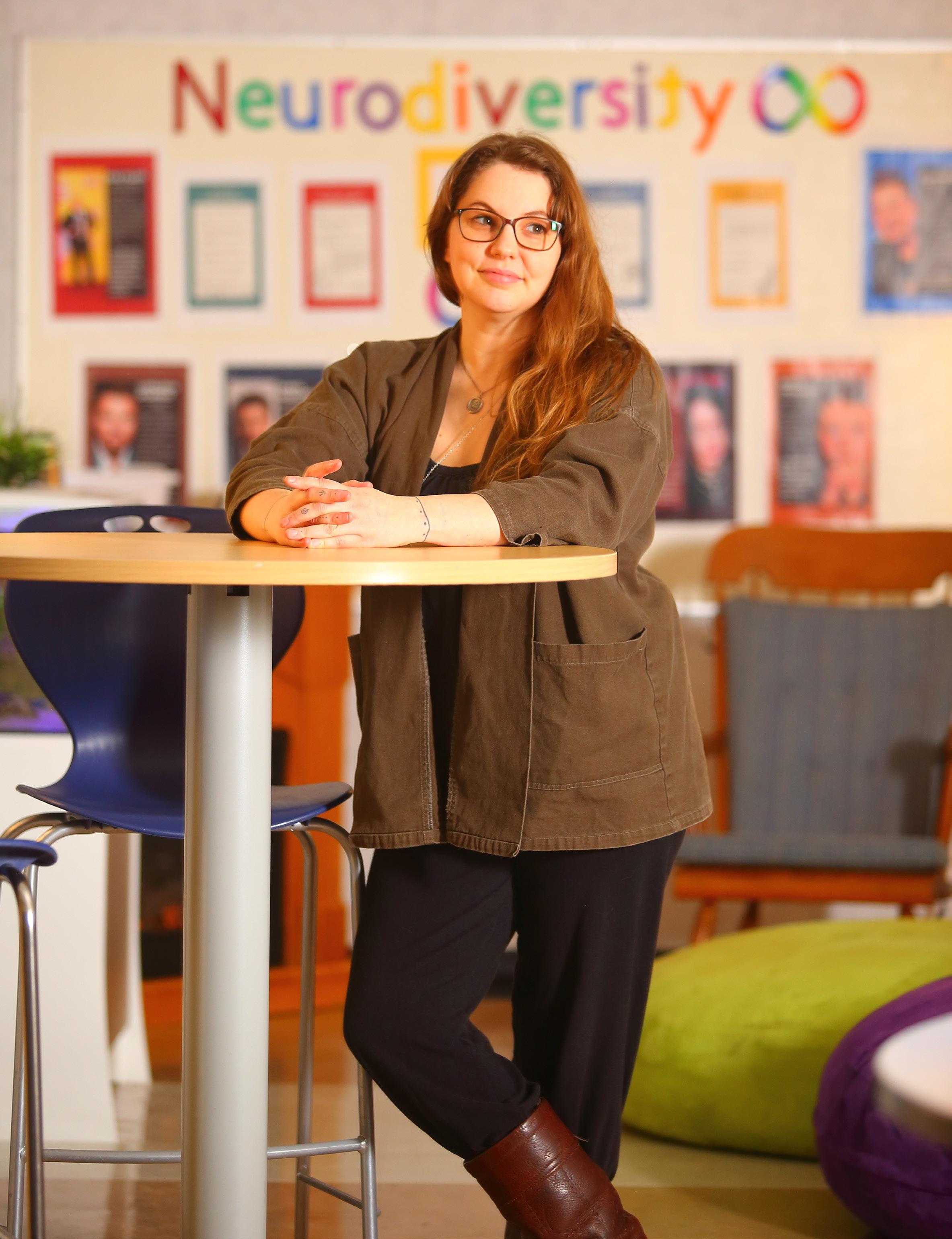 Ron Pogue photo
Ron Pogue photo
Author’s note: I use identity-first and person-first language interchangeably and without judgment; this practice reflects the desire within many neurodivergent communities to use identity-first language in the belief that their neurodivergence is an inherent and integral part of their identity.
APRIL IS OBSERVED BY MANY as Autism Awareness Month, and many self-advocates have begun to use this time as an opportunity to recognize, bring awareness to, and celebrate neurodiversity. Neurodiversity is the naturally occurring variety within human neurology and processing styles and, like all other diversities, it creates a net positive to our society. It also creates unique challenges for people who are not neurotypical. People who are neurodivergent, such as people with attention deficit hyperactivity disorder (ADHD) or autism, may struggle to navigate a world not built for them, but they also bring a lot of strengths and unique positive attributes to the table when practices are inclusive.
As a high school learning support teacher, I am keenly aware of the gap in school attendance and graduation rates between neurotypical and neurodivergent learners. In Canada, one in three autistic students do not complete high school,1 while students with ADHD are almost three times more likely to drop out of school than their neurotypical peers.2 There are also serious concerns about the significant increase in neurodivergent student mental health struggles and its relationship to school absenteeism.
As an autistic person and former student myself, I can attest to the barriers a neurodivergent person may encounter daily in the average classroom. Everything from the physical space and sensory sensitivities, to social and participation expectations, to how language and attitudes about neurodivergence can be detrimental to our sense of belonging and learning. If we as educators are to embrace diversity, we must also become more familiar with and validate the needs of our neurodiverse students.
Representation matters. It combats stereotypes and helps all students to understand that we are a diverse society with many unique experiences and perspectives. If neurodivergent students can see themselves reflected as valued and competent members of the community, they are more likely to feel comfortable and confident in expressing themselves and participating in the learning community. Neurodivergent conditions, such as dyslexia, ADHD, and autism, are fraught with stereotypes and misconceptions, and those who are neurodivergent often struggle with negative self-image and feelings of being deficient. Teachers can help combat this by becoming familiar with the strengths of neurodivergent people and using strength-based language and strategies to represent and support neurodiversity in the classroom. Did you know that many people with ADHD excel at creativity and innovation, often finding success as entrepreneurs? Students with dyslexia tend to possess visual-spatial strengths and can excel at art, construction, and engineering. Autistic students tend to have talents in finding patterns and problem-solving in unique and unconventional ways, and more and more companies are realizing that hiring autistic people leads to an increase in business performance and profits.
In an effort to celebrate neurodiversity and raise awareness Dionne Lapointe-Bakota, our teacher-librarian, featured books by and about neurodiverse people. We also created a “Celebrate Neurodiversity” display that includes the strengths and positive attributes of several common neurodivergent conditions and featured a collection of influential neurodivergent people. It will never get old watching students’ faces light up when they look at the display and exclaim, “Hey! That’s just like me!” Other ways to represent neurodiverse perspectives and people can be done through the literature you introduce to the class, using neuro-affirming symbols, like the rainbow infinity symbol; highlighting neurodiverse people’s accomplishments in history; and explicitly teaching and modeling that we all learn, process, and communicate in unique and valuable ways.
1 “Autism Spectrum Disorder: Highlights from the Canadian Survey on Disability,” Public Health Agency of Canada, 2017: www.canada.ca/ content/dam/hc-sc/documents/services/publications/diseases-and-conditions/infographic-autism-spectrum-disorder-highlights-canadiansurvey-disability/autism-infographic-eng.pdf
2 “What is ADHD?” Centre for ADHD Awareness Canada: www.caddac.ca/about-adhd/in-general/#:~:text=ADHD%20is%20a%20chronic%20
neurodevelopmental,3%25%2D5%25%20of%20adults
In Canada, one in three autistic students do not complete high school,1 while students with ADHD are almost three times more likely to drop out of school than their neurotypical peers
2
Neurodivergent people have unique considerations that can affect mental health and well-being. For example, people with Tourette syndrome, ADHD, or autism will regularly mask or camouflage behaviours to appear more neurotypical. Students with ADHD may try to sit still when their bodies need to move. Autistic students may force eye contact despite it being painfully uncomfortable. A student with Tourette syndrome may hold their tics all day only to fall apart when they get home from school. In all of these examples, the students are facing barriers to engaging in their learning because so much energy is going toward camouflaging. Both research and advocates are reporting that this propensity to mask has negative implications for mental health. Not only is it exhausting, but it leads neurodivergent people to feel like they have to hide who they are to be accepted and struggle with developing a positive self-identity. As educators, we can be mindful of this struggle and encourage all students to be self-aware of their unique—and valid—needs. We all listen, communicate, and learn in different ways. Invite students to explore and share what that looks like for them, and then come up with community agreements for how everyone’s learning needs can be honoured.
Sensory needs of most students can be met by offering a choice and variety of options while also limiting elements that can lead to sensory overload. Overhead fluorescent lights, the buzz of electronic devices, fragrances, etc., can be overwhelming, distracting, and exhausting experiences. Thoughtfully building a space where students can have a variety of sensory needs met will remove participation barriers for neurodivergent students. Here are some examples:
• Cover fluorescent lights with warm-white covers, replace fluorescent lights in your room with soft-white or warmwhite light bulbs, or use lamps and/or string lights.
• Adhere to scent-free environments. Even natural scents like essential oils can lead to sensory overload for some people.
• Reduce visual clutter in your room and on your walls.
• Provide a variety of seating options. In my experience, both neurotypical and neurodivergent high school students love to use rocking chairs, accordion stools, bean bag chairs, couches, bar stools, and hokki stools. Seating choices that allow for movement can be great self-regulation tools.
Self-stimulating behaviours, or “stimming,” help neurodivergent people express, regulate, soothe, relax, and process emotions, sensory information, and stress. Be curious about your students’ individual stims and how to incorporate their need to stim into your classroom and build in breaks to regulate. Common stims can be rocking, repetitive hand movements, pacing, playing with hair, chewing, humming, or watching visuals. We use a fish tank in our room and students often take five or ten minutes to quietly gaze at the activity in the water. Here are some other tips:
• Provide options to work or be alone. Sometimes we all need some personal space and processing time, or struggle with being unintentionally distracted or overwhelmed by peers.
• Accommodate absences. Sometimes neurodivergent people need to step away to regulate, and the stress of “missing out” or “falling behind” compounds and leads to further absences.
• Noise-cancelling headphones: understand students can be wearing these and still hear you! Noise-cancelling headphones help us reduce the overall noise of the class while also allowing us to hear voices clearly.
• Fidgets and “chewelry” can help maintain focus by keeping hands and mouths occupied.
This is just a scratch on the surface of considerations when working with neurodiverse people and, as with any population, each neurodivergent individual is unique and may have different experiences, opinions, or needs than what is reflected in this article. This serves as just the beginning of the conversation, and I invite everyone going forward to continue to be curious about neurodiversity and the lived experiences of neurodiverse people. •
Neurodiversity: The infinite variations and differences naturally occurring in human neurocognition.
Neurodivergent: A person whose neurocognitive functioning is significantly different than society’s standards of “normal” or “typical.”
Neurotypical: A person whose neurocognitive patterns are within the range of society’s standards of “normal” or “typical.”
Neuro-affirming: The belief and practice that neurodivergence is to be validated and supported, as opposed to a deficit that needs to be cured, fixed, or changed.
Did you know that many people with ADHD excel at creativity and innovation, often finding success as entrepreneurs? Students with dyslexia tend to possess visual-spatial strengths and can excel at art, construction, and engineering. Autistic students tend to have talents in finding patterns and problem-solving in unique and unconventional ways...
MENOPAUSE has become a “hot” topic in the media recently (pun intended). Its emergence as an important issue is welcome news, considering the taboo society has placed on talking openly about it. As women, we are expected to simply deal with it—quietly, and no complaining, please! This expectation results in many of us suffering in silence with little to no support. That, combined with a lack of access to family doctors, means that many of us simply endure what happens to our bodies, just as many of our mothers did, and their mothers before them. But really, as educators, do we expect our students to go through puberty without any education about their changing bodies? Of course not! Yet, as we age, many of us will experience menopause with little information and no education, unless we choose to educate ourselves. So, I decided to see what resources are out there.
In doing online information-gathering, I discovered the Menopause Foundation of Canada, a national nonprofit advocacy group launched last year. The goal of the foundation? To break the silence and start a national conversation. Count me in!
The foundation recently released a study that is the first of its kind, titled The Silence and the Stigma: Menopause in Canada. The report itself is about 20 pages in length and is easy to understand, with lots of information and anecdotes from the women who participated in the study. The study highlights the following:
• There are approximately 10 million women over the age of 40 in Canada, or one-quarter of the national population, who are experiencing or have experienced menopause.
• There are about 30 different symptoms that women may experience during menopause.
• Not surprisingly, the stigma associated with menopause has left women feeling alone and uninformed.
As a post-menopausal woman, I still enjoy reading a book to be better informed. Plus, I love the feeling of owning a book and being able to highlight sections that resonate with me. I decided to pick up The Menopause Manifesto, written by a female physician, Dr. Jen Gunter. Not only is her book very informative (almost 400 pages) and current (published in 2021) but it also made me laugh. Gunter has spent 20 years practising as a specialist in obstetrics and gynecology and writes from a feminist perspective. In her book, she explains how menopause is a neglected area of study because of patriarchal patterns in the field of medicine, combined with a lack of pharmaceutical research conducted by the male-
dominated pharmaceutical industry. Gunter’s writing is very honest and very no-nonsense: she describes menopause as “puberty in reverse.” As someone who has already experienced menopause, this made so much sense to me. Needless to say, my highlighter got quite a workout as I read!
Coincidently, in early January while viewing CBC’s The National, menopause was the focus of a segment written by veteran correspondents Iaonna Roumeliotis and Brenda Witmer. In it, they interviewed several women who have made it their business to support others going through menopause. Samantha, a personal trainer in Toronto, has a growing fitness business customizing her workouts to the needs of menopausal women. Then there is Erin, who is sharing her menopause journey as a stand-up comedian, making jokes about a topic that many find uncomfortable, especially in a public venue. In Vancouver, Shirley Weir founded menopausechicks.com, a website where people can go to get information and feel empowered. Shirley was recently a guest on the podcast Hello Menopause!, in an episode called “Normal Is a Setting on Your Dryer.” I really enjoyed browsing the episodes on Hello Menopause! as they are real menopause stories from real people. I never realized that there is so much support and information available online. Maybe that’s just my age showing.
Teaching is a female-dominated profession, and data from our pension plan tells us that retired teachers who identify as women are living to almost 90 years of age. In other words, many of us will spend about half our lives post-menopausal. It is high time that we take control over educating and managing our own health, and end the shame and stigma associated with menopause.
To read The Silence and the Stigma: Menopause in Canada and other resources, visit menopausefoundationcanada.ca.
The Menopause Manifesto, by Dr. Jen Gunter, is available at most book retailers. Visit menopausechicks.com to find out about their online community and workshops.

The Hello Menopause! podcast is available wherever you get your podcasts and at letstalkmenopause.org.

WHEN RELATIONSHIP-BUILDING, as all teachers and farmers do, there is power in finding commonalities. Where are we the same? Where can we meet? I ask my learners, “Who eats?” when I teach about relationships with the land. It’s a simple question that becomes provocative and deep. This question isn’t just about food as fuel but about food as our connection to the Earth and the stories that accompany that sustenance.
Everyone eats, so everyone should have basic knowledge of food systems. Many people have lost connections with their growers or wild spaces to harvest sustenance. School gardens and nearby wild spaces are valuable for learning basic agricultural and traditional ecological knowledge, which many students will retain for life. This article discusses some ideas for using food as a starting point to weave agricultural literacy and ecological knowledge into all subjects.
I love bringing unique, locally grown foods into my classroom. From my garden, we have sampled medlar, hardy kiwi, sea buckthorn, purple radish, ground cherry, autumn olive, persimmon, cucamelon, rainbow carrots, black cherry tomatoes, painted mountain corn, and more. Each food has a story that can be turned into a teachable moment. Where in the world was it originally grown? Who grew it? How do we have it here? Why don’t we see it in the grocery store? Are there other names for it? How do you prepare it? What health benefits are there? Are there stories or songs about it?

Food at the grocery store also has a story to tell. Let’s examine the humble carrot. Originally domesticated from wild plants in modern-day Afghanistan and Iran, ancient farmers saved seeds from the best specimens and bred different cultivars to make a rainbow of crunchy colours. Each carrot you buy from the store has been on a journey. The following is a powerful sequence of connections to discuss with your class.
First, the farmer uses a tractor to plough a field—they had to buy the tractor, and the land had to be cleared. And whose land was it? Next, they plant carrot seeds at the right time of the season using a special tool. Carrot seeds have been saved for over 1,100 years to get to this point, and the tool was made in a special workshop from steel. Then they water and weed the plants; water is piped in from a well or lake, so they have to be careful not to use too much. This too requires special equipment. They must continue to weed and water and protect the carrots from pests for 60 to 90 days before they harvest. Finally, farmers, migrant workers, or special equipment harvest the carrots, which are then sent to a processing factory where they are washed, sorted, packaged in plastic, stacked in boxes in refrigerated rooms, loaded onto trucks, and shipped to grocery stores across the continent.
For the most part, fossil fuels power each machine involved in this process. Each crop in the commercial food system shares a similar story. The story of this carrot leads to a dialogue for contrast and comparison with a more local food system, where some steps in the supply chain are eliminated. Food is a direct conduit to teaching about the climate crisis and meaningful ways to engage with it. Localizing our food system is a great strategy for adapting to climate change. Further, folks living on Vancouver Island or remote communities that depend on imported foods understand the vulnerability of the supply chain. Learners of all ages will benefit from the story of imported versus locally grown carrots, and they will be even more excited if you grow them in your school garden.
“Each food has a story that can be turned into a teachable moment. Where in the world was it originally grown? Who grew it? How do we have it here?”
“Farmer” Brown (he/him), teacher, traditional territory of the Snaw-naw-as people
One of my favourite vegetables to plant in my school garden is broad beans. People have cultivated them for over 8,000 years! This wonderful plant offers a diversity of lessons as we observe and participate in the complete life cycle. I celebrate growing these humble and nutritious legumes with my students by connecting the broad bean to several cross-curricular lessons throughout the entire school year. In October, we use the seeds as math manipulatives and for patterning and sequencing in art and storytelling (math/art/ English language arts). As a class, we then prepare a space in our garden to plant seeds in November (applied design, skills, and technologies [ADST]). The seeds plump up, germinate, survive the wet, cold winter, and sprout in January (science). As they grow, we measure them (math). We watch them flower and benefit pollinators and other nectarivorous insects (science). The flowers make bean pods that gradually plump (reproduction/health), attract pests, then attract ladybugs to eat the pests (science unit on the food chain). By June, the plants are ready to harvest and eat (career ed.).

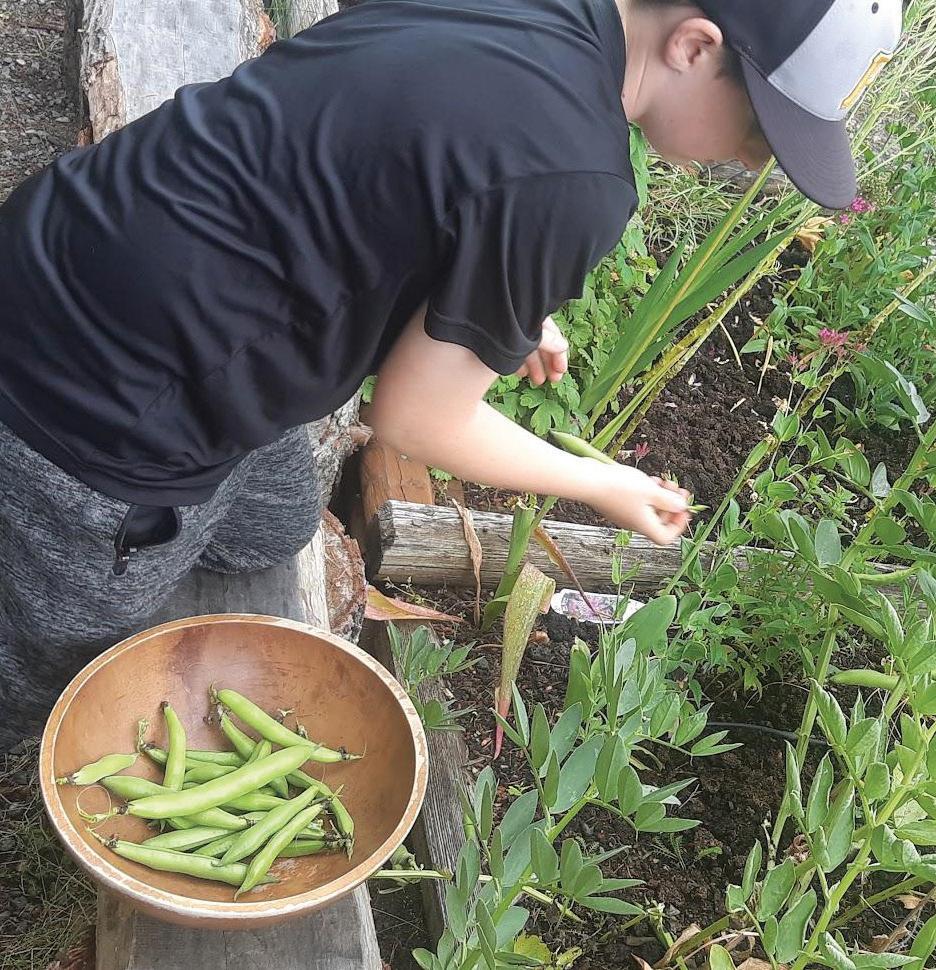
The plants can be left over summer to desiccate. Upon arrival at school in September, the dry pods are ready to be harvested and shucked. We collect data on the harvest (weight and other quantities for math), and the cycle repeats. This leads to the big idea that “seasons don’t end, they change, are circular, predictable and are worth celebrating” (Indigenous knowledge connection). Further, legumes are great for the soil and make great companion plants. The young leaves are edible, the fresh beans are delicious, and the dried beans can be rehydrated for future consumption. I have made a series of elementary-level lesson plans (available at bctf.ca/classroom-resources) inspired by broad beans. Each food or flower plant we grow can offer similar learning opportunities.
CLOCKWISE FROM TOP LEFT: Nanoose Bay Elementary school garden in May: perennials, pollinator habitat, and leafy snacks; Eco-team student harvests broad beans; Broad bean seeds: an excellent classroom manipulative and nutritious food; Farmer Brown happily gleaning apples. Author's photos.

Another success from our school to share has been tapping and harvesting bigleaf maple water to reduce it into syrup. As far as wild harvesting goes, this is gold. If you haven’t already, I highly recommend reading Robin Wall Kimmerer’s Braiding Sweetgrass: Indigenous Wisdom, Scientific Knowledge, and the Teachings of Plants My class and the eco-team club have taken on the task of identifying the trees (social studies), learning about Indigenous protocols around harvesting from the land, attaching taps and buckets (ADST), monitoring the weather (science), collecting the water (physical and health education), and boiling the water (science) to reduce it 60:1 into sugar (math). We celebrate with a waffle party (career ed.). We have been doing this for two years and now have data to compare from our annual harvest each year (math). It has been interesting and so much fun.
In closing, I gratefully remember Mrs. Parker, my Grade 4 teacher, a farmer. Her grounded and inspired teaching style may have influenced me to become a farmer and now a farmer-educator. I want to help learners understand that everyone eats for a living. Farming, especially by means of regenerative agricultural practices, and other Earth-carebased professions are important in adapting to the climate and biodiversity crisis. Abundance comes from caring for and respecting the land. Many students will have their first experience of this hopeful practice in school gardens and wild spaces.
FROM THE OUTSIDE, the Streetfront program portable is nothing spectacular. It’s a grubby brown colour with some artwork painted on to add personality. On the inside, however, you can tell it’s no ordinary classroom. Shelves piled with outdoor equipment line the walls. Photos of students and community members having adventures of a lifetime are hung with care. The photos are a reminder of how far they have come together and an inspiration that fuels future adventures.
The Streetfront program is an alternative education program in Vancouver’s Downtown Eastside. Since its founding in 1977, the program has centred on an active-based pedagogy with many opportunities for students to engage in physical activities and outdoor experiential education.
While students are given an opportunity to explore a variety of sports in the physical education curriculum, what sets Streetfront apart is its unique running program. Streetfront is proud to be home to the largest team of high school marathoners in the world.

 Streetfront students training for a marathon.
Streetfront students at the Seattle Marathon.
Streetfront students training for a marathon.
Streetfront students at the Seattle Marathon.
S t r
Students go the distance, reach new heights
The students coming into the Streetfront program are not elite athletes when they arrive. Instead, they train tirelessly together every day to accomplish their goal of finishing a marathon. Many of the students are living through significant personal and family challenges and are in the program because they have experienced disruption to their education. Many have been marginalized by the very systems meant to support them. The running program helps them see just how much they are capable of and learn skills that are transferable to other areas of their lives. Gord Howey, Barry Skillin, and Trevor Stokes, respectively the youth and family worker, support staff, and classroom teacher at Streetfront, have spent the last 20 years building students’ confidence through the running program.
“A marathon is a perfect metaphor for what we try to teach the kids,” said Trevor. “The only way to get the marathon done is to do it yourself. You have to persevere. In the moment, it can feel like it’s too much, but with support, they have the strength to get through.”
When they first started running marathons, they had very few people waiting at the finish line to applaud students’ accomplishments. However, as the program has grown, and alumni return year after year to support the current cohort, the group of supporters has grown. They’ve also had more buy-in from families as parents see their kids working hard to reach a goal. Some parents start running with their kids, others do what they can to make sure their kids are getting to school each day,

and many wait at the finish line to cheer for the Streetfront team. Engagement from families and students, including attendance, has improved drastically with the running program.
“They say it takes a community to raise a child, but we’ve seen the reverse here,” said Barry. “You support the child, and the effects trickle out into the community. It goes beyond just one student and impacts the whole family.”
Gord, Barry, and Trevor also challenge their students in other ways throughout the school year. In addition to the regular academic classes at Streetfront, students participate in outdoor education where they take on challenging hikes, camping trips, and other outdoor adventures.
“College wasn’t a thought; graduating wasn’t a thought. I didn’t even think I would have a house and a family. I didn’t think I would make it past 18. Trevor gave me the confidence to believe that I could do what I wanted to do. I live a life that I never ever, ever could have dreamed of."
– Gage Ladouceur, former student
As the outdoor program grew, the team had an idea for a new project called Street2Peak. The goal of Street2Peak is to visit five continents with students and complete a challenging outdoor adventure on each continent. So far, the group has climbed Mount Kilimanjaro in Tanzania, completed the W Trek in Patagonia, and hiked the Rees-Dart Track and Tongariro Alpine Crossing in New Zealand.

The Streetfront program receives no additional funding for their adventures with students. Instead, the program is funded by donors who see the team complete marathons and see the impact Gord, Barry, and Trevor have on students and families in the Downtown Eastside.
“If you wait for the system to create something, you’ll wait forever,” said Barry. “You have to hustle and create opportunities.”
For some students, the opportunity to take a trip through Streetfront is life changing.
“The farthest I’ve gone was Seattle. To land and get off a plane when I’m a little city girl from East Van…it was crazy. It was really amazing,” shared former student Savannah Dawson, who was a part of the team to climb Kilimanjaro.1
It’s a rigorous training process to prepare for the hikes and marathons. This training builds strong collegiality among the students and staff. Gord, Barry, and Trevor see every student as strong, capable, and full of potential. And all three participate in every activity they ask students to complete. Whether it’s an art project, a physical education class, eating lunch, or training for a run or hike, all three staff at Streetfront are right beside the students every step of the way.
“It’s important they see that we’re doing the same things we’re asking them to do,” said Gord. They model the commitment it takes to succeed at any given task. This equal participation between students and staff goes a long way in relationship-building and encouraging reluctant students to participate.
Former student Yara O’Sidhe shared, “Somewhere in the motions of those actions, a family is built. A family I’ve sensed some of the most loyal and integral support and love from in my entire life. No matter which year you go to Streetfront, and no matter what group of students you talk to or ask, that much is guaranteed. A family.”2
The bond the educators share with students lasts long after students graduate from Streetfront. Alumni frequently return to run and volunteer with current students and to say hello to the educators who changed their lives. Students coming back years after they leave the program shows just how deep these relationships are. This program not only teaches students commitment, dedication, and perseverance, the three buzzwords that guide Streetfront’s pedagogy, but also gives students hope and confidence to pursue a future they may not have previously imagined for themselves.
“College wasn’t a thought; graduating wasn’t a thought. I didn’t even think I would have a house and a family. I didn’t think I would make it past 18. Trevor gave me the confidence to believe that I could do what I wanted to do. I live a life that I never ever, ever could have dreamed of. I owe a lot to Streetfront and Trevor. You guys saved my life,” said former student Gage Ladouceur.3
While Gord, Barry, and Trevor have many student success stories to share, they also have their fair share of difficult days. The emotional toll of working with vulnerable students is high; however, the support system they have created with each other has gotten them through the last 20 years.
After working together for 20 years, Gord, Barry, and Trevor describe each other as best friends rather than colleagues. They joke that they’ve had only four staff meetings in 20 years. Instead, they talk and collaborate every day, at school and after school. They support each other on difficult days and celebrate together when a student or the team experiences success.
“The emotional stamina needed to stay in this job cannot be undervalued. So many have to leave. The stories are just too sad. The three of us never left, and I know why. Because we had each other,” said Trevor.4
This year; however, marks Gord’s final year with Streetfront. Since joining the program in 2003, Gord has taken three international trips with students, ran countless marathons, saved a few lives (literally), and inspired hundreds more.

When asked what he’ll miss most, he answered, “The people I’m around all day.” The people at Streetfront truly are the heart and soul of this program. Their shared vision for uplifting, supporting, and building confidence in their students has led to the creation of a program that shows students they are capable, strong, and valuable members of their community. Streetfront is a model for how public education can build up communities and change lives. •
Learn more about Streetfront in Streetfront: Stories about Perseverance, Resilience, and Running in the Downtown Eastside, an edited anthology that highlights student and teacher perspectives on the impact and work of this program.

1 Bettina van Hoven (ed.), Streetfront: Stories about Perseverance, Resilience, and Running in the Downtown Eastside, Urban and Regional Studies Institute, Groningen, 2022, p. 40.
2 Ibid. p. 33.
3 Ibid. p. 92.
4 Ibid. p. 135.
AH, THE LONELY DRAMA TEACHER. Often the only one of their kind in the ecosystem; isolated in the windowless theatre; nearly buried under the weight of scripts, costumes, casting, counselling, set building; and motivated by the unshakable belief in the benefits of collaboration, communication, and creative expression.
Sometimes observed as a curiosity by colleagues, the drama teacher’s natural inclination is to celebrate and to be inspired by the ever-evolving community of teachers and learners at school, but the drama teacher can rarely disentangle themselves from cast, crew, and student needs while the layered deadlines of show-making loom. Sound familiar?
Our most depleted resource is often time, and, like many committed professionals, we often feel forced to deprioritize the time required to reach out, to connect, and to collaborate with our colleagues. Part of a healthy teaching practice and growth mindset, collegial dialogue and cross-pollination is often relegated to “someday…when the rehearsal schedule clears.”
Fear not, intrepid educator! Not only are you seen, and valued, you share so much with so many around the province. This article will give you a few ideas for tapping into the pulse of other drama teachers and theatre professionals, like you.
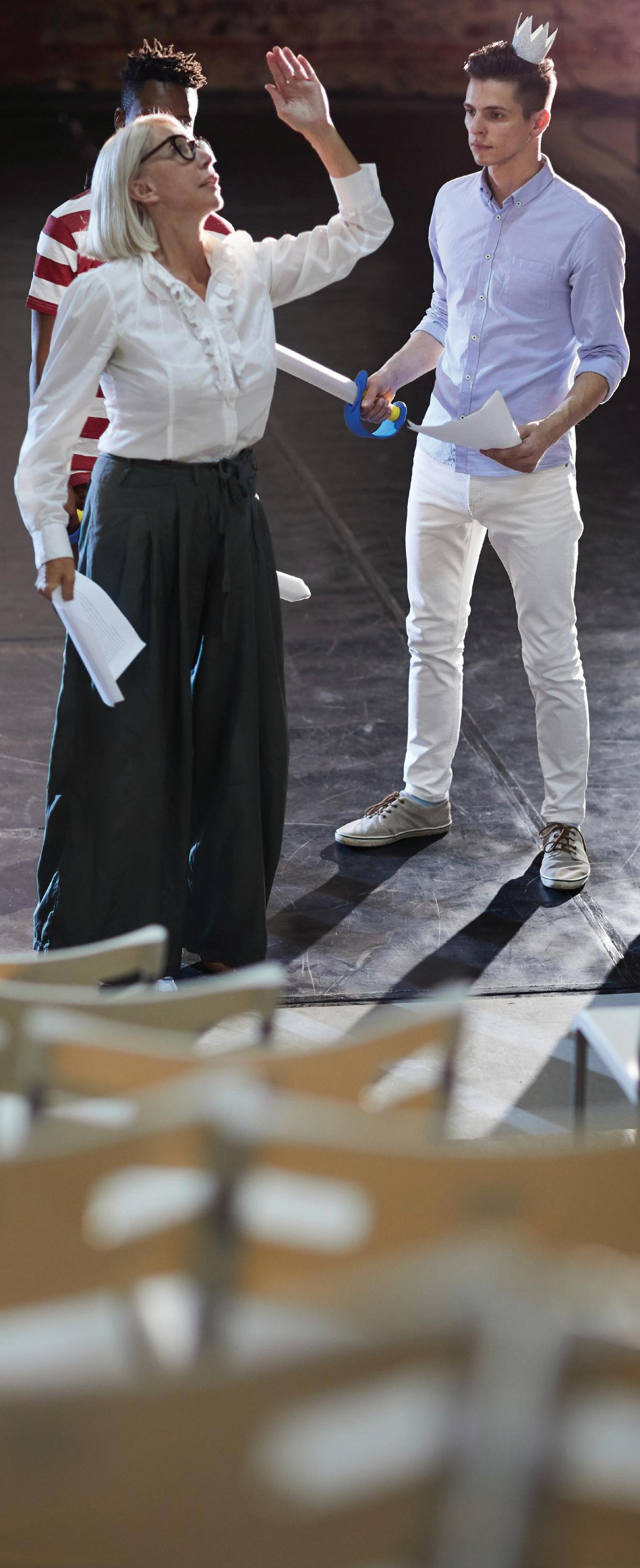
Obviously social media is a great way to virtually connect with other drama teachers. Facebook groups are generative spaces to share news, ideas, and inspiration. Try searching #dramateacher on Instagram or TikTok for a laugh—or even a lesson plan! There are also several resource-rich websites run by drama and applied theatre pros. Check out the list on the opposite page for online resources worth a visit.
There are other ways to use digital media to get connected with professional theatre: Sharmila Miller, drama teacher at Garibaldi Secondary School in Maple Ridge, has her students attend virtual workshops run by A Class Act NY, an awardwinning acting studio established in 2005 by Jessica R. Grosman. The studio offers workshops hosted by prominent actors (stage and screen), agents, directors, and more! The learning outcomes for these online workshops can be tailored to your students’ needs; the host is often streaming from their professional industry setting, allowing for an authentic glimpse into their creative career. In Garibaldi’s workshop last year with Thayne Jasperson, students “went backstage” at the Richard Rodgers Theatre, where Hamilton is still going strong. The digital format allows for unique learning opportunities, which might otherwise be inaccessible, without a plane ticket!
For the face-to-face experiences that motivated you to choose theatre in the first place, register for a conference, take your students to a festival, or join a professional community of drama educators. For over 50 years, the Association of British
By Sharmila Miller, Maple Ridge; Laurie Anne Lorge, Vernon; and Nicole “Coco” Roberge, Port Coquitlam; drama teachersColumbia Drama Educators (ABCDE) has advocated for theatre and drama teachers in BC as your official provincial specialist association (PSA). Supported by the BCTF and by membership fees, the ABCDE sponsors an annual professional development conference, an annual spring festival, an annual playwriting competition, several scholarships, teacher awards, a newsletter, and more. The ABCDE Executive, elected annually by members, works to adapt, defend, share, and develop theatre, drama, and related curricula while building community across our province. During BC’s dedicated PSA day in October we emerge from our studios, theatres, and classrooms to play, think, learn, and grow together with industry innovators like Principal Intimacy Professionals, Biz Books, ActSafe BC, and Urban Ink. Conference faculty always includes local working creatives like Omari Newton, Susan Bertoia, Peter Abando, Davey Samuel Calderon, Cat Hagquist, and Peter Jorgensen. The ABCDE conference is fuel for your fire; the atmosphere is one of safe, creative risk.
One of the best opportunities to meet other drama teachers and connect your students with like-minded theatre kids is to attend a festival. Several areas throughout the province hold zone festivals where your work can be showcased and adjudicated. Select plays move on to the BC National Theatre School DRAMAFEST in May, at Douglas College in New Westminster, where student casts and crews get to relish in the joy of a diverse theatre-loving audience from across the province. The three-day DRAMAFEST includes workshops, shows, and social opportunities. (Though the kids tell us that the comfy robes at the Inn at the Quay in New Westminster are the real draw!) Students love DRAMAFEST. If you do not have an active zone, consider becoming the zone representative. Reach out to the ABCDE for support; there is possible grant money available.
Not interested in a competitive festival? The Good Will Shakespeare Festival held in Vernon in late April is another option. The mission of “Shakesfest,” as it is affectionately called, is to provide secondary school students and educators with the opportunity to meet and learn from a variety of internationally acclaimed actors, musicians, and artists. The festival attracts world-class performers and teachers to work with the attendees. Lana O’Brien, Festival Co-ordinator says, “There are so many great things about Shakesfest for students, but one of the best things for me has been the decades-long friendships I’ve made with incredibly talented and creative people.”
There are many, many opportunities for drama teachers to provide rich and meaningful opportunities for their students. Sometimes we forget that these opportunities also have benefits for the teacher. Not only can we learn from online resources, conferences, and festival workshops, but we can also meet other educators, creators, and future collaborators who extend our knowledge and understanding of the transformative power of theatre education. Most importantly, we can make friendships that make us feel just a little less like the only one of our kind. •
ABCDE on Facebook
Drama Teaching Resources
Drama Teachers Sharing Group
Drama Teacher Hub
Theatre Production Resources Vancouver
Maada’oonidiwag Anti-Racist Canadian Theatre Exchange
WEBSITES FOR INSPIRATION AND IDEAS

www.thedramateacher.com
www.thedramaclass.com
www.theatrefolk.com
www.bcdramateachers.com
www.dramaonlinelibrary.com
Teachers can join any number of provincial specialist associations (PSAs) covering a wide variety of subject areas, pedagogies, and focus areas for professional growth. The PSAs have a long history of providing teachers with learning opportunities at conferences or through workshops, sharing resources with members, and building professional communities and connections.
In 1971, several different PSAs, each with its own focus and constitution, came together for the first official meeting of the PSA Council. The PSA Council included delegates from current PSAs who collaborated on conference planning, publications, and member recruitment. BC drama teachers came together to create a new PSA in 1973 with encouragement from the PSA Council at the time.
To learn more about the history and current work of some PSAs, visit bctf.ca/news-and-stories to read articles written by PSA members to celebrate more than 50 years of professional community. For more information on joining any of the 33 PSAs, visit bctf.ca/services-information and click on the Professional Development tab.
Celebrating 50+ years of BCTF provincial specialist associations

FIRST SESSION
Saturday evening—March 18
7:00 p.m. Call to Order Traditional Welcome Preliminaries
Report of the President Leadership Report Social Justice
8:30 p.m. Report of the Nominating Chairperson
• Statements from FullTime Table Officer Candidates
• Q&A Session for FullTime Table Officer Candidates
Call for Nominations
9:25 p.m. Announcements
9:30 p.m. Adjournment
SECOND SESSION
Sunday morning—March 19
9:00 a.m. Guest Speaker— Sam Hammond, CTF
9:10 a.m. Finance
11:00 a.m. Guest Speaker— Karen Ranalletta, CUPE BC
11:10 a.m. Unfinished Business
12:25 p.m. Announcements
12:30 p.m. Adjournment
THIRD SESSION
Sunday afternoon—March 19
2:00 p.m. Guest Speaker— Sussanne Skidmore, BCFED
2:10 p.m. Constitution and By-laws
4:45 p.m. Report of the Nominating Chairperson
• Statements from Member-at-Large Candidates
• Q&A Session for Member-at-Large Candidates
Call for Nominations
Unfinished Business
6:25 p.m. Announcements
6:30 p.m.
FOURTH SESSION
Monday morning—March 20
9:00 a.m. Guest Speaker— Honourable Rachna Singh, Minister of Education and Child Care
9:30 a.m. Education Policy
Ministry of Education
Unfinished Business
12:25 p.m. Announcements
12:30 p.m. Adjournment
FIFTH SESSION
Monday afternoon—March 20
2:00 p.m. Guest Speaker— Chris Schultz-Lorentzen, BCCPAC
2:10 p.m. Bargaining
3:00 p.m. Keynote Speaker— Ahmed Ali Knowmadic
3:45 p.m. Annual General Meeting
Certification and Teachers’ Council
Teachers Teaching on Call Teacher Education
5:25 p.m. Announcements
5:30 p.m. Adjournment
SIXTH SESSION
Monday evening—March 20
7:30 p.m. In Memoriam
Canadian Labour Congress/BC Federation of Labour Organization of the BCTF
Provincial Specialist Associations
Professional Development
8:45 p.m. Report Questions
Unfinished Business
9:10 p.m. Report of the Nominating Chairperson
Final Call for Nominations
9:25 p.m. Announcements 9:30 p.m. Adjournment
SEVENTH SESSION
Tuesday morning—March 21
9:00 a.m. Elections
Professional Ethics, Rights, and Standards
Professional Relations
10:30 a.m. Guest Speakers— Mercedes Martinez, Miguel Angel Rivera, and Edwin Morales Laboy, Federation of Teachers of Puerto Rico
11:00 a.m. Health, Welfare, and Safety of Teachers
Unfinished Business
11:45 a.m. Executive Director’s Report
12:00 p.m. Awards
12:25 p.m. Announcements
12:30 p.m. Adjournment
EIGHTH SESSION
Tuesday afternoon—March 21
2:00 p.m. Guest Speaker— Arnie Lamber t, BCRTA
2:10 p.m. Pensions
Political Action
Induction Ceremonies and Awards
Unfinished Business
5:25 p.m. Announcements
5:30 p.m. Adjournment
NINTH SESSION
Tuesday evening—March 21
7:30 p.m. Privatization and Commercialization
Unfinished Business
New Motions
9:25 p.m. Courtesy Motion
9:30 p.m. Adjournment
That By-law 7.2 be amended as follows:
The Judicial Council (JC) shall be composed of a two chairpersons, who shall be elected by the Representative Assembly, and an additional 18 26 members, all of whom who shall be elected by the Representative Assembly. At least one of the chairpersons and at least 12 of the additional members shall be Aboriginal, Indigenous, Black, or persons of colour. All members of the Judicial Council shall be active members of the Federation entitled to vote and must receive a majority of the votes cast by the Representative Assembly. When a Judicial Council member resigns from or otherwise leaves the Judicial Council, the member’s appointment to the Judicial Council may continue solely for the purpose of completing ongoing proceedings.
That a new By-law 5.21 be adopted as follows:
(a) An Executive Committee member may be removed from office by a two-thirds majority vote at the Annual General Meeting or a Special General Meeting.

(b) An Executive Committee member may be suspended from office by a unanimous vote of the other Executive Committee members.
That the last sentence of By-law 5.1 (a) be amended as follows:
An Executive Committee member may be removed from office under the provision of By-law 1.7, By-law 5.21, or By-law 7.
That By-law 20 be amended as follows:
Only the Annual or Special General Meeting can amend the Constitution, the by-laws, the Salary Indemnity Plan Regulations, and the Code of Ethics and only if a 75% majority of the delegates vote in favour of the amendment(s) passed by at least two-thirds of the votes cast by delegates on behalf of the voting members. Only the Annual or a Special General Meeting can amend the Salary Indemnity Plan Regulations and only if passed by at least three-quarters of the votes cast by delegates on behalf of the voting members
That By-law 8.1 be amended as follows:
(a) The Annual General meeting of the Federation shall be held during the month of March or April at a date, time, and place to be fixed by the Executive Committee.
(b) Notice of the date, time, and place of every Annual General Meeting or Special General Meeting, the text of every special resolution, and, in the case of an Annual General Meeting, where to access the audited financial statements shall be sent by email to every active member in good standing who has provided the Federation with an email address.
(c) Notice of the date, time, and place of every Annual General Meeting or Special General Meeting, and the text of every special resolution, shall be available to every active member in good standing through the secured member portal on the BCTF website in the three weeks 21 days prior to the Annual General Meeting.
(d) The audited financial statements of the Federation, including the Salary Indemnity Fund, shall be available to every active member in good standing through the secured member portal on the BCTF website in the 21 days three weeks prior to the Annual General Meeting.
That By-law 9 be amended by adding a new (d) as follows: within 60 days of the Executive Committee receiving a written request from at least 10% of the voting members of the Federation, in accordance with the Societies Act, a Special General Meeting will be held.
That By-law 18.1 be amended as follows:
All books, documents, and other records shall be kept in the office of the Federation. With the exception of those books, documents, or records containing information confidential to members or former members, or in-committee minutes, these books, records, and documents may be examined by any member upon their giving to the Executive Director due notice in writing to that effect. If a member wishes to examine records that include information confidential to members or former members, or in-committee minutes, they may write to the Executive Director who will consider the request.
Nothing hereinbefore contained shall prevent the examination by a member of books, documents, and records concerning that member, that have been designated by the Executive Director under By-law 5.7 as confidential.
That By-law 5.1 (b) be amended as follows:
Notwithstanding the foregoing, each Member-at-Large shall be elected for a term of two years. If for any reason a Memberat-Large leaves the position after only one year, a successor shall be elected to fill the unexpired portion of the two-year term. Should a Member-at-Large, part way through their term of office, accept nomination to run for a table officer position, their position as Member-at-Large shall be declared vacant as of the following July 1.
That By-law 5 be amended by adding a new (g) as follows: Executive Committee members may not concurrently serve as Executive Committee members and Local Representatives or local delegates to the Annual General Meeting or hold BCTF appointed or elected roles, except as assigned by the Executive Committee as part of their Executive Committee duties.
That By-law 8.2 (b) be amended as follows:
Voting by Local Representatives and Delegates at the Annual General Meeting or a Special General Meeting is by way of delegate voting. Local Representatives and Delegates act as delegates for the voting members of their local for the purpose of the meeting. Each voting member has one vote, which is allocated to the Local Representatives and Delegates for their local. Each local shall adopt policies that address the distribution of votes among delegates from the local. Each member of the Executive Committee holds a single vote and is not included in the local member count for the purpose of the Annual General Meeting delegate voting.
That a new By-law 5.23 be added as follows: The Federation will not make donations to:
1. any federal, provincial, or municipal political party.
2. any individual candidate or group of candidates seeking office in any federal, provincial, or municipal election.
3. any individual seeking the nomination for any federal, provincial, or municipal party.
Concomitantly, the Federation may not directly affiliate to any political party. Locals of the Federation have the autonomy with regard to political donations but will not use Federation grants for this purpose.
That the third point in the stem of Procedure 31.A 02 be amended as follows:
Commitment to Democratic Processes in co -ordination with Aboriginal Ways of Knowing and Being.

That By-law 5.1 be amended by adding a new (g) as follows: To ensure a balance representative of the membership as a whole, of the seven non-designated Member-at-Large positions, at least two be held by those that self-identify as men, at least two be held by those that identify as non-binary and/or equity seeking, and at least two be held by members who self-identify as women.
Prince George
That By-law 5.1 (a) be amended as follows:
There shall be an Executive Committee, which shall consist of a President, First Vice-President, Second VicePresident, an Immediate Past-President (when applicable), and nine ten Members-at-Large, elected in such a manner as to ensure that at least three Member-at-Large vacancies are filled at each Annual General Meeting. One Member-atLarge position shall be designated to be held by a Member of Colour, and one shall be designated to be held by an Aboriginal member, and one shall be designated to be held by a 2SLGBTQ+ member The designated positions shall have the same term and role as the non-designated positions. The Executive Committee positions are elected by the Annual General Meeting and shall take office on the following July 1. Each member of the Executive Committee shall be a member in good standing entitled to vote, in accordance with By-law 1.1. An Executive Committee member may be removed from office under the provisions of By-law 1.7 or By-law 7.
Prince George
That By-law 5 shall be amended by adding a new (g) as follows:
The Member-at-Large position designated to be held by a 2SLGBTQ+ member is open to the election of a member who identifies as 2SLGBTQ+.

Executive Committee recommendation
That the BCTF Code of Ethics, Procedure 31.B.02 be amended to add a new 10. as follows:
In the course of union business and meetings, the member must not discriminate against any other member because of race, colour, ancestry, place of origin, political belief, religion, marital status, family status, physical or mental disability, sex, sexual orientation, gender identity or expression, or age of that person or member, or because that person or member has been convicted of a criminal or summary conviction offence that is unrelated to the membership or intended membership, or any other protected grounds under the BC Human Rights Code.
I’M GRATEFUL that this year I got to represent teachers as President. Taking the lead role in public advocacy, returning to in-person engagement at meetings, achieving a new contract: it was a busy year.
The key issue we face right now is the teacher shortage. It increases workload, erodes services, worsens mental and physical health, and makes union engagement harder. It interplays with social issues like housing, childcare, postsecondary access, and others. We need co-ordinated advocacy and proposed solutions on these issues to make teaching a more viable career until there is no shortage.
As co-lead negotiator at the bargaining table, I pushed the employer on issues most important to members. It’s clear that, despite the improvements made, we have much to do between rounds to engage members to understand their priorities and ensure a clear strategy
I HAVE BEEN A BOOTS-ON-THEGROUND classroom teacher for 27 years. I am a Social and Eco Justice Rep, Staff Rep, and co-founder of the BCTF Divest Now campaign. At our last AGM, delegates voted overwhelmingly in favour of a resolution directing our Executive to lobby the Teachers’ Pension Plan to divest our dirty pensions from such earth-destroying companies as Kinder-Morgan, TMX, Chevron, and Coastal Gas Link. Thus far, one letter has been sent. We are in a climate emergency and I expect our union leadership to act like it. I have spent the last year and a half in meeting after meeting with divestment specialists. We have a pathway to divestment, but it is going to take some will and some work.
I have watched as the job of a classroom teacher has gone from manageable to almost undoable. Classrooms are starved for resources and education
around workload gains our members need.

I remain committed to both personal and collective learning and action on both reconciliation and anti-racism. I know the Federation review that has begun will lead to real progress on those issues within our union and look forward to that work.
It would be a privilege to work with all of you as President again next year.
facebook.com/clint.johnston.92
twitter.com/ClintJohnston7
International: CTF Delegation Head, EI World Congress; ISTP 2018; Bolivia 2016
National: CTF Vice-President 5x
Provincial: BCTF First & Second VicePresident, Member-at-Large
Local: President & other
Teaching: 20 yrs; BEd Elementary & BHK (UBC)
assistant time is woefully inadequate. In October, Surrey reported over 90 teacher assaults. Teachers are beaten up. They are burnt out. Our students are not receiving the supports they need to learn safely. If I am elected President, we will be back in the media fighting for our students, as we used to.
Local: Long-term Staff Rep, Social-Eco Justice Rep
Teaching: 27 years of teaching both elementary and secondary Education: BA (Hons.) from Simon Fraser University in English and Psychology


IT’S BEEN AN INTERESTING TIME to transition to First Vice-President, with all table officers moving in to and on to new roles during a bargaining year. I took on additional responsibilities and engaged members in ratification of the new collective agreement, one that saw improvements in salary and extending pregnancy SEB to all locals.
Workload remains a significant issue in BC and across Canada. The teacher shortage affects access to PD and leaves; it erodes student supports because of internal coverage; and it places increased expectations on all teachers. The BCTF can centre member input and engage the Ministry, employer, and partner groups to find a path forward that meets teachers’ needs and benefits students.
Extensive advocacy needs to continue— advocating for time to implement the reporting policy and Indigenous grad requirement, appropriate Indigenous and anti-racism resources, and funding to meet the needs of teachers and all students in public education. We
REPRESENTING TEACHERS as your Second Vice-President this year has been a privilege. I’ve appreciated opportunities to connect with members and local leadership from around BC, and to advocate on your behalf at the provincial level.
As a lead negotiator on the Provincial Bargaining Team, I brought a capacity to synthesize and communicate complex concepts, to identify new strategies and opportunities, and to effectively engage the employer to achieve gains. As we implement the improvements won in this round, we’re also preparing for the next round. I’m excited about talking with teachers as we strategize together around working conditions and other important issues.
There’s lots to be done away from the bargaining table too. Teacher recruitment and retention remains a priority. Some issues, like housing and childcare, affect all workers, and so we’ll continue working with other unions to advance our shared goals.
can create union spaces and schools that are inclusive, diverse, and safe environments for learning and working.
I have a demonstrated commitment to the work of supporting members across BC, and I hope to continue the necessary and hard conversations within the Federation and across public education.
facebook.com/carole.gordon.921 twitter.com/CaroleGordonBC
Provincial: First VP (current), Second VP (3yrs), Executive (7yrs), Pensions, CTF Trustee, AGM (20yrs)
Local: Executive (Second VP, H&S, Bargaining), Staff Rep
Community: Labour Council President, United Way

Teaching: Prep, classroom, TTOC (since 1991)
In schools and as a union, we’re committed to truth, reconciliation, and antiracism, which require a willingness to be unsettled, learn independently, hold brave conversations, and embrace change. I’m committed to this ongoing work.
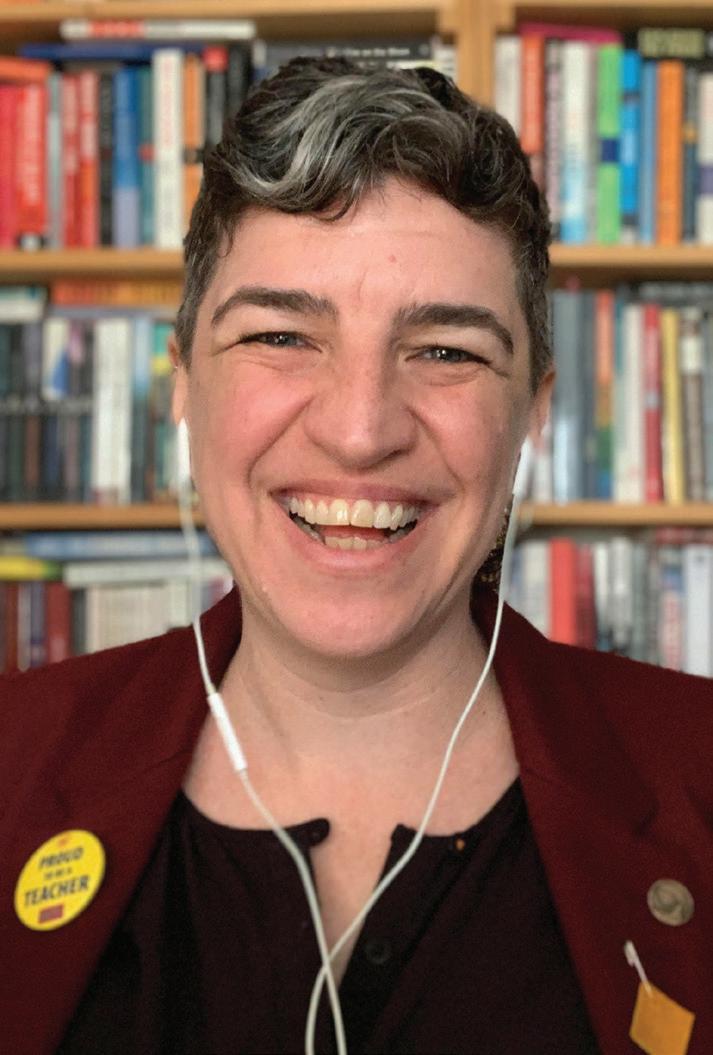
Thank you for all you do in your schools, communities, and locals. I look forward to serving alongside you in the coming year.
robintosczak.ca
facebook.com/rbntzk
twitter.com/rbntzk
Provincial: Second Vice-President; Member-at-Large; Provincial Bargaining Team; Teacher magazine & TTOC advisory committees, workshop facilitator
Local: Executive (First VP, Grievance Officer, H&S, LR, Treasurer); Labour Council; Contract & Bargaining committees
Teaching: Elementary, ELL, inclusive education
SECOND VICE-PRESIDENT Robin Tosczak
Greater Victoria
SUPPORT, STRENGTH, AND DEPENDABILITY are three characteristics that I will contribute as Memberat-Large. Listening to the needs of the membership, engaging in meaningful dialogue, and supporting members in difficult times are skills I bring to the table.
I am a second-generation teacher and have taught for 24 years, primarily in special education. I am very involved locally and provincially and look forward to the possibility of representing the membership on the Executive Committee.

I believe in the importance of amplifying regional voices, teaching areas, and diverse perspectives and will work hard to support opportunities for greater participation and representation in the BCTF. I want to be part of the team that continues to build a more inclusive Federation, which values unique voices and experiences.
I want to be part of the leadership team that moves from acknowledging
NEW IS NOT A BAD WORD. There are barriers that early-career members face in leadership positions when they are seen as too new or too young. I see my newness as a strength. As an earlycareer elementary music and classroom teacher, I have a unique perspective that allows me to ask hard questions about the way things are done. I have brought motions to the Executive Committee that challenge the status quo or envision a different process or way of communicating, all with the goal of increasing access or engagement for members. I listen with a fresh perspective.
experience to changing practice. This means listening to the needs of locals/ sublocals and ensuring the structures of the Federation support the good work that happens across BC.
I look forward to hearing from members and working with you to strengthen the Federation. Thank you in advance for your support, and I look forward to being your representative at the provincial table.
Provincial: Chair/member of PIAC, Ministry’s COVID Restart Advisory Committee, BCTF workshop developer/ facilitator, TIE-BC Conference Chair
Local: Contract, Professional Issues Officer, PD, Social Justice Chair Teaching: 24 years elementary classroom and elementary/ secondary special education Education: BA, BEd, MEd Special Education
that we are not accepting violence as normal for our profession. Now is the time to be creative, bold, and willing to invest time and resources to organize members in discussions about their working conditions, workload, and their safety.
mfranzmann0.wixsite.com/mariahec
Provincial: BCTF Executive Committee
Member-at-Large, Women in Negotiations, AGM delegate
Local: LR, Member-at-Large, TTOC Rep, Bargaining Team, Early Career LSA VP
Teaching: Elementary music, primary classroom, learning assistance, ELL
Education: BA, BEd, MA Education Policy MEMBER-AT-LARGE Mariah
I worked hard throughout our bargaining round to provide openness and transparency and to centre members’ voices. The deal may be ratified, but the work is not done. Teachers deserve a workplace that is free from harm, yet we currently have an epidemic of violence in our schools that must be addressed. Earlycareer and new teachers need to know

WORKING FOR YOU! My time as an active and engaged Local Representative has brought me insight into the needs of our members. There is no easy answer to fix the social inequities that have shaped education, but I know through unity, determination, and persistence we can create a just path forward.

From sitting with NEVR founder Dr. Balbir Gurm, discussing the effects of race-based data collection, to wearing my #redfored, proudly reminding the public that teachers never stopped caring throughout the pandemic, I know that representing members, my peers and friends, is not easy work. But it’s the right thing to do; it’s what I do.
Words without action are meaningless. I have walked the line, stood in solidarity, rallied back, and patiently listened. Passion drives me, but action achieves working conditions that create better places to learn and work in.
Public education is integral; it creates innovators, artists, and pragmatists; it puts food on our tables, and it helps shape our lives. A system that hears all voices, reflects on its faults, and is collaborative, is a system that helps keep teachers active, healthy, and here in BC.
rickkumartheteacher.weebly.com facebook.com/kickitwithrick
National: CLC Young Workers Caucus
Provincial: BCTF Agenda/Resolutions
Chair, H&S facilitator, CASJ, Local Representative, BCFED Executive Council, BCFED Young Workers’ Committee Chair, Ombudsperson
Local: Executive, Members of Colour, Grievance, H&S, Young Workers, Pro-D Rep, NWDLC
Teaching: Secondary socials/English/LST
AS A BLACK EDUCATOR who grew up in Jamaica and taught in Nunavut, my current role as a learning support teacher provides me with a comprehensive perspective on the most pressing issue facing teachers today: deteriorating working conditions. I will bring an intersectional and an antioppression lens to any solutions for the untenable working conditions teachers endure.

My role as a parent of children in the BC public education system would also inform my contributions to discussions about what can be done to ensure that BC has a viable public education system. Finding a way out of “no way” is a skill I learned in my previous career in the travel industry. Collaborating with others in achieving goals is something I practise regularly, not only as a Staff Rep and committee chair, but also as a dragon boat paddler.
I look forward to working together with a group of knowledgeable and passionate educators to ensure that BC teachers’ working conditions provide the best learning conditions in public schools in BC.
facebook.com/MarilynRickettsLindsay twitter.com/lynlindsay
National: CTF AGM and Tri-National Conference delegate
Provincial: AGM, Rep. Assembly, and Bargaining Conference delegate; PSI facilitator; AOEC member
Local: STA executive; Local Representative; SJ contact; International Solidarity, Resolutions, Environmental Justice, PA/PR committees; Staff Representative
THIS IS MY 29TH YEAR as a French immersion primary teacher. I’m currently the First Vice-President and Grievance Officer of the PGDTA. As a BCTF Member-at-Large, I seek out and listen to members’ concerns and ideas, both through my liaison role with local presidents and with individual teachers, and bring these forward at the provincial level. I have a strong voice and use it to represent members.
I’m proud that we successfully bargained our provincial collective agreement; we must now continue efforts to improve working conditions. Hearing your ideas and input on bargaining strategies and goals for the next round is crucial. I will ensure your voice is conveyed at the Executive table.
In addition to my passion for teaching and union work, I also love acting in community theatre productions, singing, travelling, and spending time with family and friends. It’s important that we improve our working conditions so that all teachers can enjoy healthy work-life balance.
The BCTF members featured on pages 31–35 and listed below are presented by the Nominating Committee (in alphabetical order for each position). These members have been nominated pursuant to By-law 5.4 (page 11 of the Members’ Guide to the BCTF) for positions on the Executive Committee. Additional nominations may be made from the floor of the AGM.
For President—one to be elected
Clint Johnston, Chilliwack
Jillian Maguire, Vancouver Secondary
For First Vice-President—one to be elected
Carole Gordon, Central Okanagan
For Second Vice-President—one to be elected
Robin Tosczak, Greater Victoria
Members-at-Large—four to be elected
Non-designated (4)
Jo Cornthwaite, Nanaimo
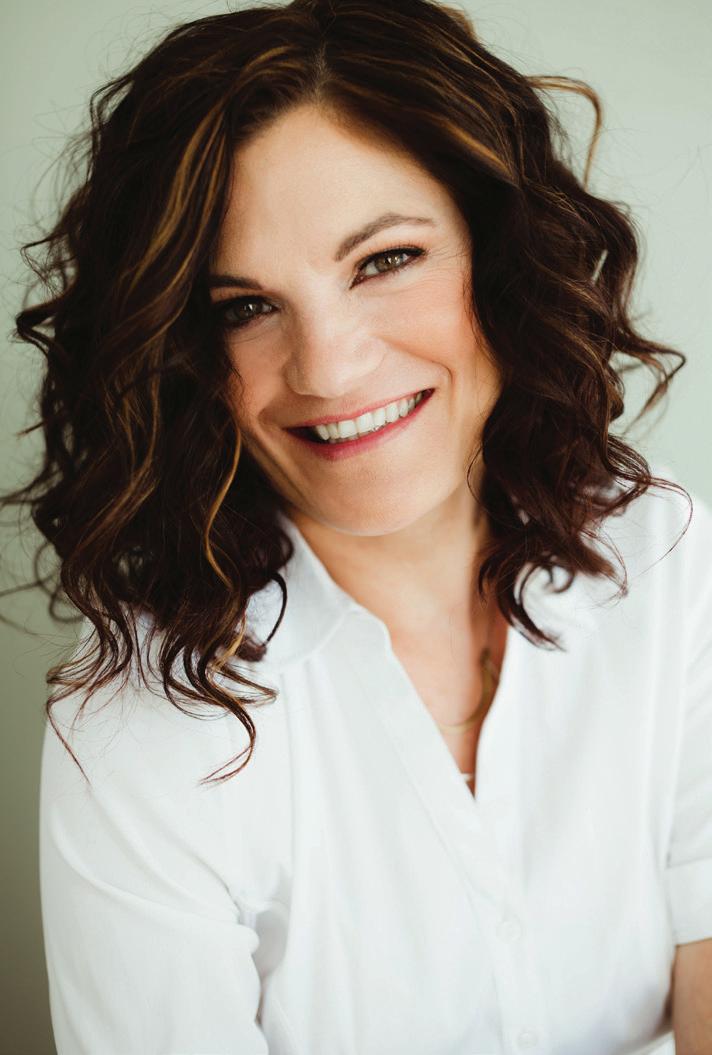
Mariah Franzmann, Prince George
Rick Kumar, Surrey
Marilyn Ricketts-Lindsay, Surrey
Katherine Trepanier, Prince George
The best part of this work is meeting members from across the province. Despite the many challenges we continue to face, I remain excited for the future of the BCTF. Together, we will fight, advocate, and continue to make gains for our profession.
katherinetrepanierbctf.com
facebook.com/KatherineTrepanierBCTF
Provincial: BCTF Member-at-Large (4 years), WLC/BAC, Local Representative, AGMs, Bargaining Conferences, FLI Local: First VP, Lead Bargaining Negotiator, Grievance Officer, Staff Representative
Education: MEd in Educational Practice, BA, PDP (SFU)

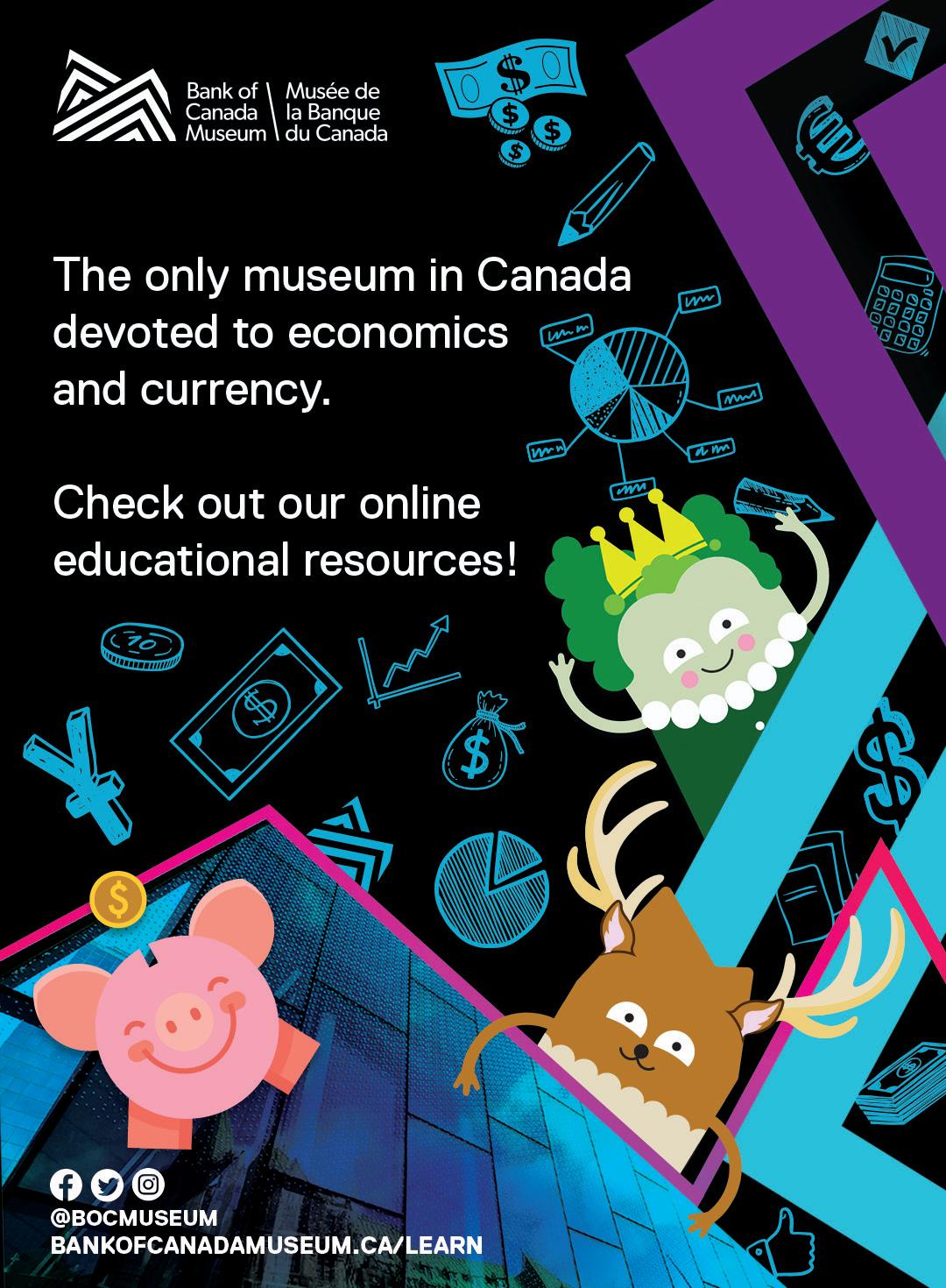



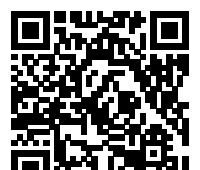
Centre Paris, privately owned, 1 bedroom, everything included, $1,875/week: irene.roland@gmail.com
Gulf Island Getaway
Website: www.timdmcgowan.wixsite.com/mysite

Email: timdmcgowan@hotmail.com to reserve
You often never know the impact you have made, but occasionally a former student will contact you to share the impact you’ve had on their lives.
-Kyle H, Secondary Teacher
Across BC, there are opportunties to grow as an educator; be inspired and inspire others. Find your calling on www.makeafuture.ca/teach
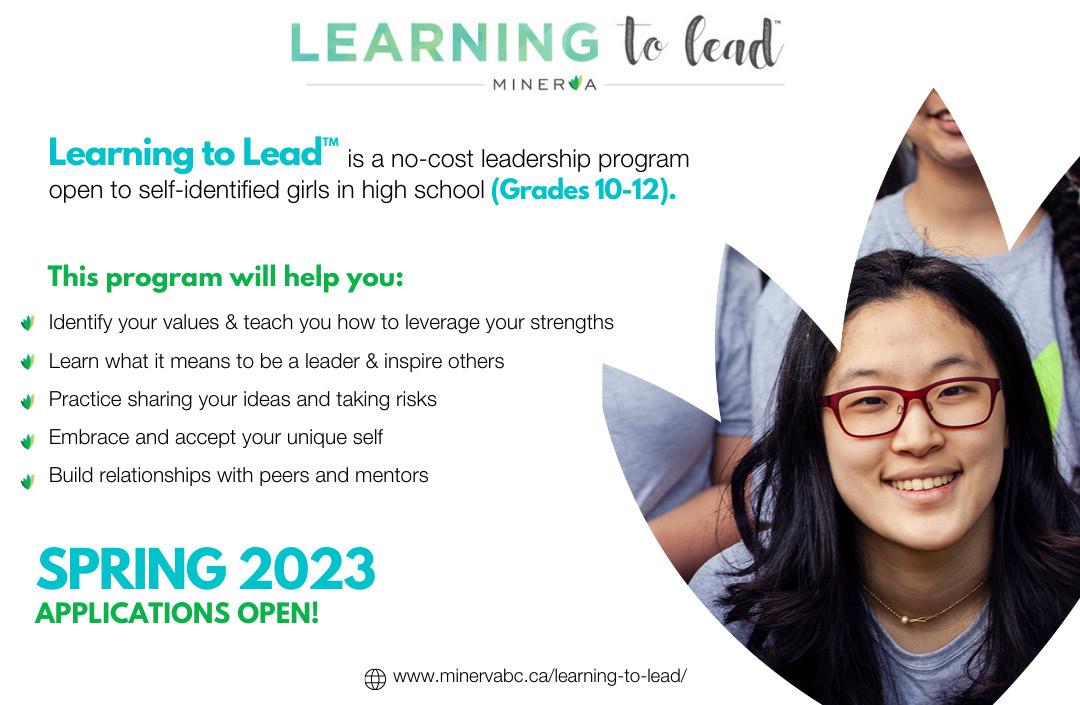
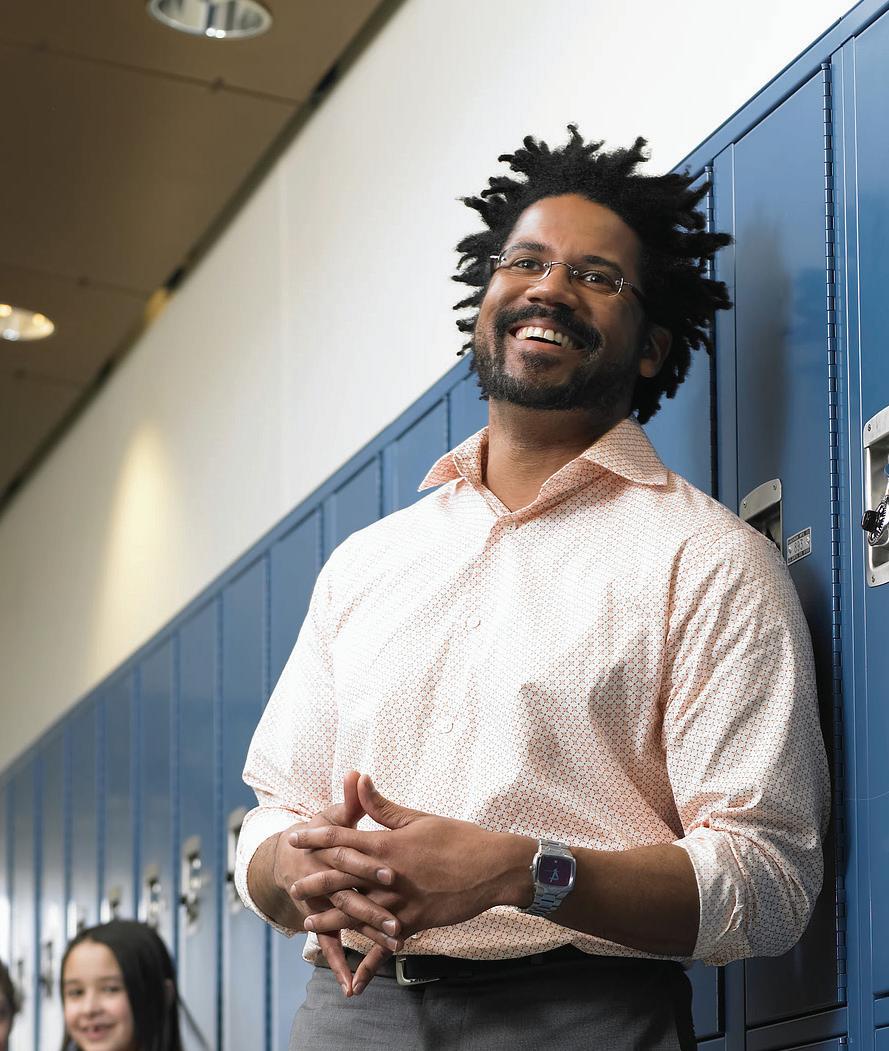










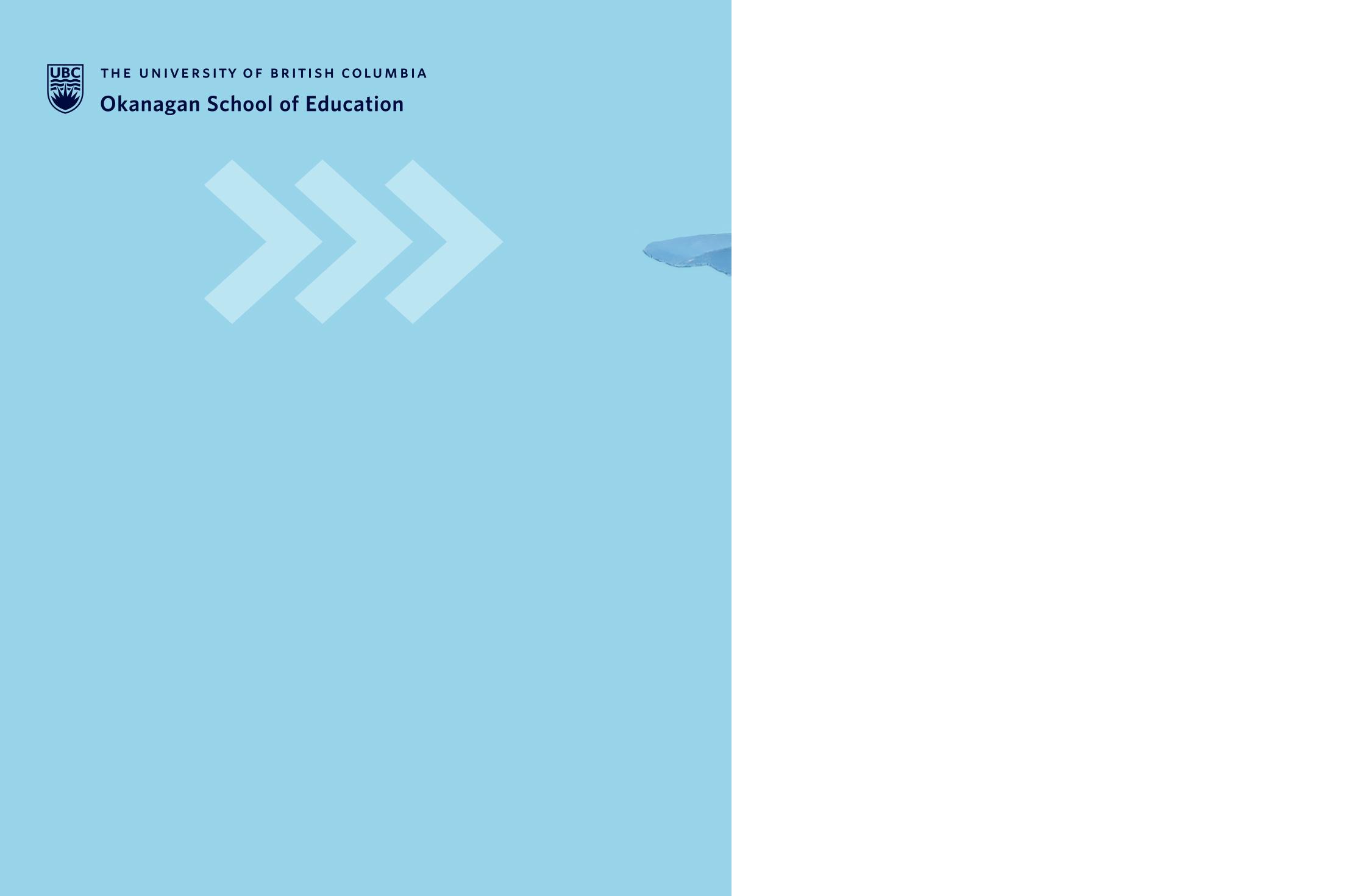

ONLINECOURSESINCLUDE
● SpecialEducation
● BCFirstNations,MetisandInuitPeoples
● MathematicStrategiesforAt-RiskStudents
● Reading&LiteracyinthePrimaryGrades
● SocialEmotionalLearning
● Teaching&LearninginanIntercultural Setting

● TeachingSTEMinGrades11&12
● TeachingThroughInquiry
TQS-APPROVEDPOST-GRADUATE CERTIFICATES*
● EarlyChildhoodEducation
● EnglishLanguageLearners
● MathematicsinEducation
● SpecialEducation
● TeacherLibrarian
● TeachingScienceGrades11&12
*CandidateswhocompletePost-GraduateCertificateswillhave creditsappliedtotheGraduateDiplomainEducationand ProfessionalMasterofEducationthroughtheSpecialized AppliedGraduateExperience(SAGE)program.
Formoreinformation,visit COURSESFORTEACHERS.CA/BC

Canada Post Corp. Agreement No. 40062724
Return undeliverable Canadian addresses to BCTF, 100–550 West 6th Avenue, Vancouver, BC V5Z 4P2 email: teachermag@bctf.ca
ABOVE
See pages 8–11 to read "Witness blanket: A project toward reconciliation" by Muryn Jordon, and learn about how her class created a witness blanket to express and continue their learning about truth and reconciliation.
Send images of student art to teachermag@bctf.ca for a chance to be featured in Teacher magazine.
